
Exhibit 99.3 4th Quarter Earnings Conference Call January 20, 2022

2 2021 overview (1) Non-GAAP, see appendix for reconciliation. (2) Highest annual capital markets revenue since starting to rebuild those capabilities in 2014. Adjusted Pre-Tax Pre- Provision Income(1) Diluted Earnings Per Share Adjusted Total Revenue(1) Adjusted Non- Interest Expense(1) Net Income Available to Common Shareholders $667M $0.43 $1.6B $967M $414M • 2021 reported pre-tax pre-provision income(1) represents the highest level on record. • 2021 adjusted pre-tax pre-provision income(1) increased 2% vs. 2020. • 2021 net charge-off ratio of 24 bps lowest since 2006. • Growing & diversifying revenue; generated record 2021 capital markets revenue(2) of $331M. $2.7B $2.49 $6.4B $3.7B $2.4B 4Q21 FY 2021

3 Strong foundation- accelerating growth Innovating through investments and business segments to accelerate growth 2021 active digital users are up 7%, including active mobile banking users up 12% YoY; Mobile enhancements: Chat; View statements & check/ deposit images; FICO score; "What's New" carousel 4Q digital consumer checking sales increased ~50% YoY; includes expanded cross-channel sales capabilities through banker dashboards ~70% of 4Q consumer transactions were through digital channels; Enhancements: Improved transaction data feed; PFM; Add'l Zelle functionality 2021 digital commercial services revenue up 13% YoY(7) Digital investments generate return Increased Mortgage Loan Originator (MLO) headcount by ~160(2); added client facing associates in growth mkts. across Wealth Mgt. and Corporate Bank Consolidated ~490 branches; opened ~80 De Novos(3) Growing highly efficient business segments Strong & recovering markets Expanding capabilities through bolt-on acquisitions: 2021 One Pass commercial users up 8% YoY EnerBank Ascentium (1) Highest annual capital markets revenue since starting to rebuild those capabilities in 2014. (2) Since 2017. (3) From 1/1/2014 to 12/31/2021. (4) Source: S&P Global Market Intelligence. (5) Source: U.S. Postal Service. (6) Per VISA Business and Economic Insights - Regional U.S. Economic Outlook, August 2021. (7) Includes iTreasury and Online Banking Business Services module & transaction fees. 19 of Regions' top 25 MSAs projected to grow faster than national average(4) 16 of nation's top 25 markets with net migration inflows are within Regions' footprint(5) Southeast region expected to recover the fastest to pre-pandemic employment levels(6) Grew consumer checking accounts by 3% and small business by 5% Increased new corporate loan production by ~30% and generated record annual capital markets revenue(1) 2021 net retail account growth exceeds previous 3yrs combined; growth rate is 3x higher than pre-pandemic Sabal Capital Partners Clearsight Advisors Growing & diversifying revenue

4 • 4Q adjusted loans grew 7% on an ending basis and 6% on an average basis ◦ Excl. ~$3B acquired EnerBank loans, full-year ending adj. loans increased 4% and full-year average adj. loans decreased 3%. • Commercial pipelines have surpassed pre- pandemic levels, production remains strong, and line of credit commitments increased $4.7B YoY; line utilization increased to 42.3% • Consumer loans reflected acquired EnerBank loans as well as another strong quarter of residential mortgage and modest growth in credit card. ◦ Expect consumer exit portfolios to have an average impact of ~$700M in FY22. • Expect full-year 2022 reported average loan balances to grow 4-5% compared to 2021. Loan growth momentum (1) Non-GAAP, see appendix for reconciliation. $79.8 $80.5 $86.0 52.4 53.2 55.6 27.4 27.3 30.4 4Q20 3Q21 4Q21 (Ending, $ in billions) $80.3 $79.8 $84.3 52.9 52.7 54.0 27.4 27.1 30.3 4Q20 3Q21 4Q21 Adjusted loans and leases(1) (Average, $ in billions) Adj. business loans(1)Adj. consumer loans(1) QoQ highlights & outlook

5 $119.8 $131.9 $136.7 69.9 79.1 80.9 40.6 42.5 42.7 8.9 9.9 10.1 0.4 0.4 3.0 4Q20 3Q21 4Q21 Deposit growth continues (1) Other deposits represent non-customer balances primarily consisting of EnerBank brokered deposits. Average deposits by segment ($ in billions) Wealth Mgt Other(1) Consumer Bank Corporate Bank QoQ highlights & outlook • Pace of deposit growth has slowed, balances continued to increase to new record levels. • Average deposits QoQ growth primarily due to higher account balances and addition of EnerBank deposits. ◦ EnerBank 4Q average deposits were $2.6B and ending deposits were $2.3B; and are included in Other deposits(1). • 2021 consumer checking accounts grew 3% and small business accounts grew 5%. ◦ 2021 net retail account growth exceeds previous 3 years combined. • Based on analysis of deposit inflow characteristics, we currently believe ~35% of pandemic-related deposit increases can be used to support longer term asset growth through the rate cycle. • The remaining balance performance is uncertain; however, additional balances are likely to persist over initial rate increases. Providing a favorable funding mix when compared to prior cycles.

6 $1,017 $976 $1,029 3.13% 2.76% 2.83% 3.40% 3.30% 3.34% 4Q20 3Q21 4Q21 NII(1) NII & margin performance NII and NIM(1) ($ in millions) (1) Net interest income (NII) and net interest margin (NIM) are reflected on a fully taxable-equivalent basis. (2) Non-GAAP; see appendix for reconciliation. NIM • In 4Q, deposit and cash balances remained elevated. • PPP and cash account for -51 bps NIM and $42M NII within the quarter (+3 bps / +$8M QoQ) ◦ PPP loans account for +9 bps NIM and $39M NII within the quarter (+4 bps / +$8M QoQ) ◦ Excess cash accounts for -60 bps NIM and $3M NII (-1 bps / $0M QoQ) • Total of ~$15.5B deployed through active balance sheet management (including securities purchases and borrowings reductions) since pandemic began, balancing risk and return. • 18% cash-to-earning asset ratio positioned well for rising rate environment. NIM excl. PPP/Cash(2)

7 Loan accrual adj • Linked-quarter NII expected to grow modestly in 1Q22 excluding reduced PPP contributions ◦ Environment conducive for continued loan growth ◦ Stability from rate environment; fixed rate loan production and securities reinvestment yields neutral to runoff ◦ 2 fewer days reduce NII ~1% ◦ 89% of PPP loan fees have been forgiven; expect 1Q22 PPP NII contribution to be in the $8M-$12M range • Excluding PPP/cash, adjusted NIM(1) expected to increase into the upper-3.30%s • Longer-term NII growth from organic and strategic asset growth; positioned to benefit from rising market rates Loan bals/mixHedges • Adjusted loan(1) growth excl. EnerBank in 4Q21 of +~$1.3B average and +~$2.4B ending • Rate environment impacts continue to be offset through active balance sheet management ◦ Hedging benefit of $112M NII in 4Q(3) ◦ Lower deposit pricing; 4Q deposit cost = 4bps / interest-bearing deposit cost = 7bps • Negative non-recurring accrual adjustments include outsized credit interest recovery in 3Q and a lease adjustment in 4Q (1) Adj. NIM excludes PPP and excess cash over $750M. Adjusted NIM, and adjusted loans are non-GAAP; see appendix for reconciliations. (2) Market rate impacts include contractual loan, cash, and borrowings repricing; fixed asset turnover at lower market rates; and lower deposit yields. (3) QoQ increase in hedge NII from repositioning transactions; hedges mostly remain active; ~$1.5B total return, $686M NII accrual since beginning of 2020, $830M unrealized pre-tax gain, to be amortized into NII over the remaining life of hedges. $965 $1,019NII Attribution Drivers of NII and NIM 4Q21 3Q21 -2bps +1bps -1bps +4bps-2bps -$9M +$3M +$4M +$8M-$6M +$53M Expectations for 1Q22 and Beyond NII NIM EnerBank +9bps Stable core NII excluding loan accrual adjustments NII & margin - core drivers PPPMarket rates(2)

8 25bps rate hike adds +$60-80M of NII over 12 months • ~$17B annual fixed rate loan production and securities reinvestment; mostly exposed to middle tenor(1) rates • Reduced premium amortization from lower prepay speeds Interest Rate Exposure • ~50% floating rate loans excl. hedges • Hedge maturities beginning in 3Q22 ◦ Recent decisions to shorten our hedge protection allows our sensitivity levels to increase throughout 2022 • Large stable deposit funding base and historically low betas ◦ Assume 25% deposit beta for all interest-bearing deposits over first 100bps tightening; including a blend of lower betas on legacy deposits and higher betas on surge deposits ◦ Experienced ~10% deposit beta over first 100bps prior cycle • Large cash balance well positioned as rates rise Short-term Rate Sensitivity Drivers Long-term Rate Sensitivity Drivers 94% 90% Regions Peer Median 18% 13% Regions Peer Median Cash-to-Earning Assets(2) Deposits-to-Earning Assets(2) • Regions' balance sheet is asset sensitive; well positioned for rising short-term and/or long-term interest rates 1 2 3 4 Net Receive Hedge Notional(3) (Quarterly Avg) 4Q21 Adjustments 1Q22 2Q22 3Q22 4Q22 $20.5B $20.5B $19.4B $11.5B (1) ~70% fixed rate production has life of 5 years or less. (2) 3Q ending levels latest comparison available; source: SEC reporting; peer banks include CFG, CMA, FHN, FITB, HBAN, HWC, KEY, MTB, PNC, SNV, TFC, USB, ZION. (3) Net receive hedge notional reflects receive- fixed hedges minus pay-fixed hedges. Includes all active swaps/floors entered into prior to 12/31/2021.
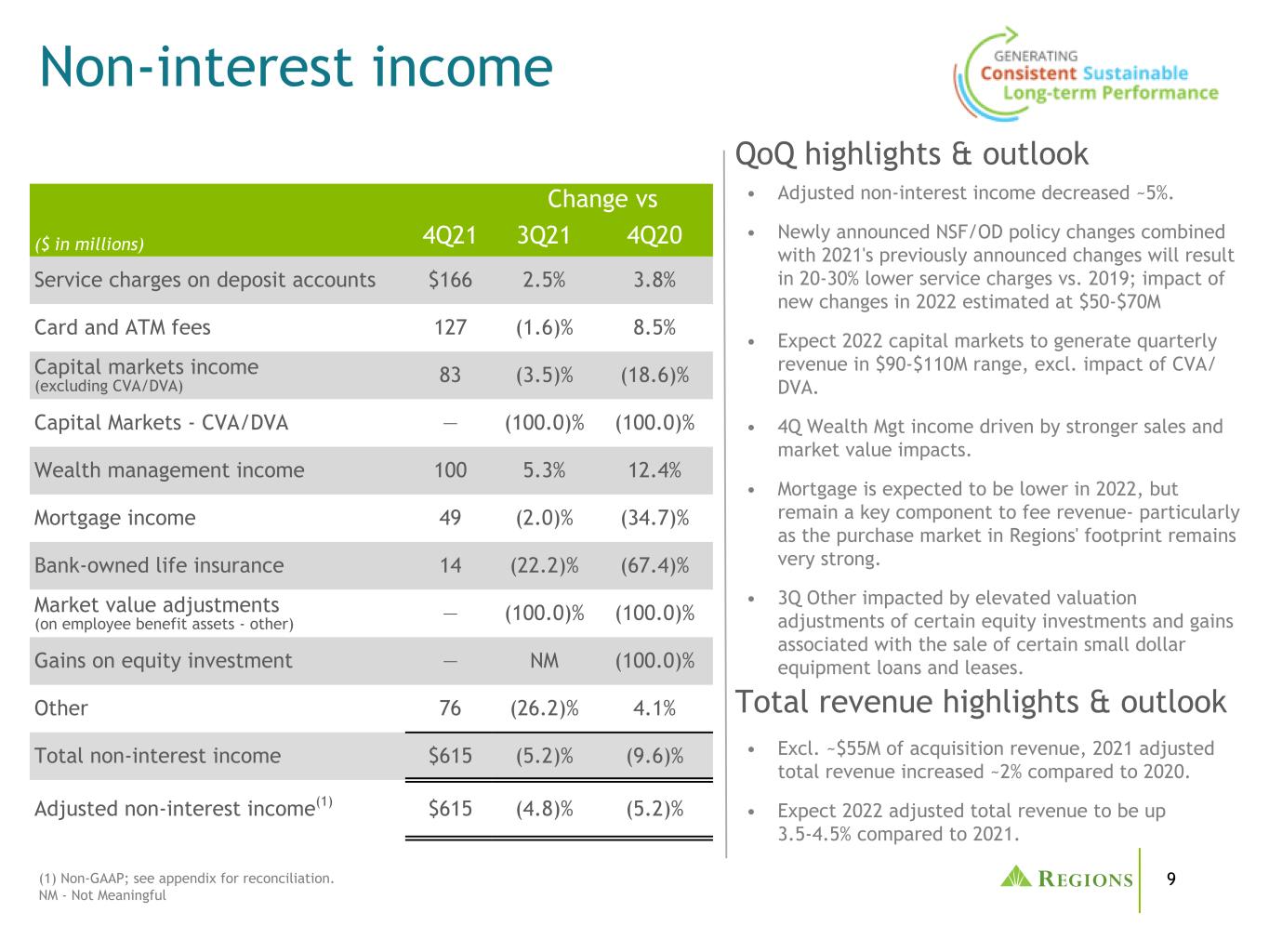
9 • Adjusted non-interest income decreased ~5%. • Newly announced NSF/OD policy changes combined with 2021's previously announced changes will result in 20-30% lower service charges vs. 2019; impact of new changes in 2022 estimated at $50-$70M • Expect 2022 capital markets to generate quarterly revenue in $90-$110M range, excl. impact of CVA/ DVA. • 4Q Wealth Mgt income driven by stronger sales and market value impacts. • Mortgage is expected to be lower in 2022, but remain a key component to fee revenue- particularly as the purchase market in Regions' footprint remains very strong. • 3Q Other impacted by elevated valuation adjustments of certain equity investments and gains associated with the sale of certain small dollar equipment loans and leases. Change vs ($ in millions) 4Q21 3Q21 4Q20 Service charges on deposit accounts $166 2.5% 3.8% Card and ATM fees 127 (1.6)% 8.5% Capital markets income (excluding CVA/DVA) 83 (3.5)% (18.6)% Capital Markets - CVA/DVA — (100.0)% (100.0)% Wealth management income 100 5.3% 12.4% Mortgage income 49 (2.0)% (34.7)% Bank-owned life insurance 14 (22.2)% (67.4)% Market value adjustments (on employee benefit assets - other) — (100.0)% (100.0)% Gains on equity investment — NM (100.0)% Other 76 (26.2)% 4.1% Total non-interest income $615 (5.2)% (9.6)% Adjusted non-interest income(1) $615 (4.8)% (5.2)% Non-interest income (1) Non-GAAP; see appendix for reconciliation. NM - Not Meaningful QoQ highlights & outlook Total revenue highlights & outlook • Excl. ~$55M of acquisition revenue, 2021 adjusted total revenue increased ~2% compared to 2020. • Expect 2022 adjusted total revenue to be up 3.5-4.5% compared to 2021.
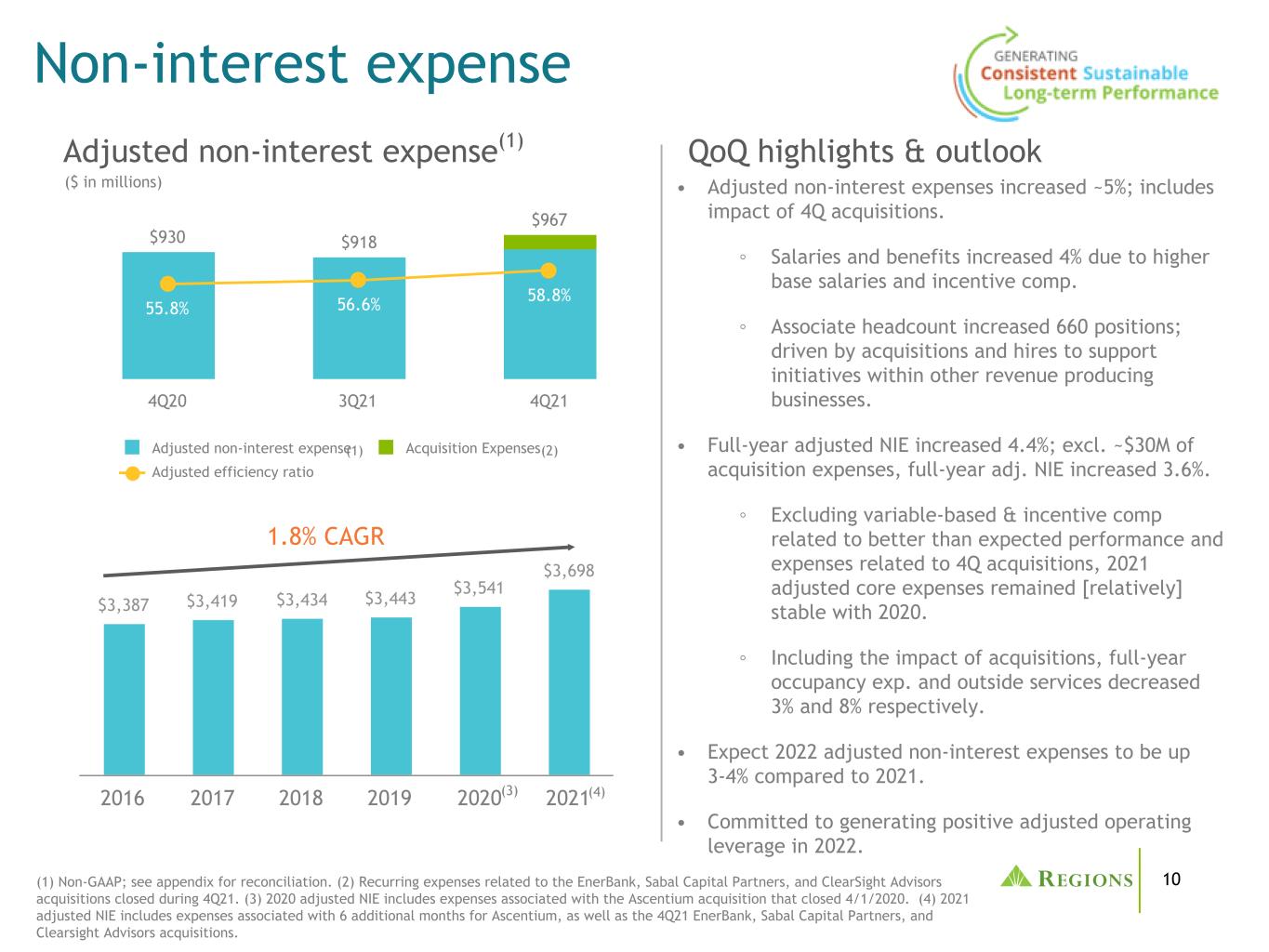
10 $930 $918 $967 55.8% 56.6% 58.8% Adjusted non-interest expense Acquisition Expenses Adjusted efficiency ratio 4Q20 3Q21 4Q21 $3,387 $3,419 $3,434 $3,443 $3,541 $3,698 2016 2017 2018 2019 2020 2021 • Adjusted non-interest expenses increased ~5%; includes impact of 4Q acquisitions. ◦ Salaries and benefits increased 4% due to higher base salaries and incentive comp. ◦ Associate headcount increased 660 positions; driven by acquisitions and hires to support initiatives within other revenue producing businesses. • Full-year adjusted NIE increased 4.4%; excl. ~$30M of acquisition expenses, full-year adj. NIE increased 3.6%. ◦ Excluding variable-based & incentive comp related to better than expected performance and expenses related to 4Q acquisitions, 2021 adjusted core expenses remained [relatively] stable with 2020. ◦ Including the impact of acquisitions, full-year occupancy exp. and outside services decreased 3% and 8% respectively. • Expect 2022 adjusted non-interest expenses to be up 3-4% compared to 2021. • Committed to generating positive adjusted operating leverage in 2022. (1) Non-GAAP; see appendix for reconciliation. (2) Recurring expenses related to the EnerBank, Sabal Capital Partners, and ClearSight Advisors acquisitions closed during 4Q21. (3) 2020 adjusted NIE includes expenses associated with the Ascentium acquisition that closed 4/1/2020. (4) 2021 adjusted NIE includes expenses associated with 6 additional months for Ascentium, as well as the 4Q21 EnerBank, Sabal Capital Partners, and Clearsight Advisors acquisitions. Non-interest expense QoQ highlights & outlookAdjusted non-interest expense(1) ($ in millions) 1.8% CAGR (3) (4) (2)(1)
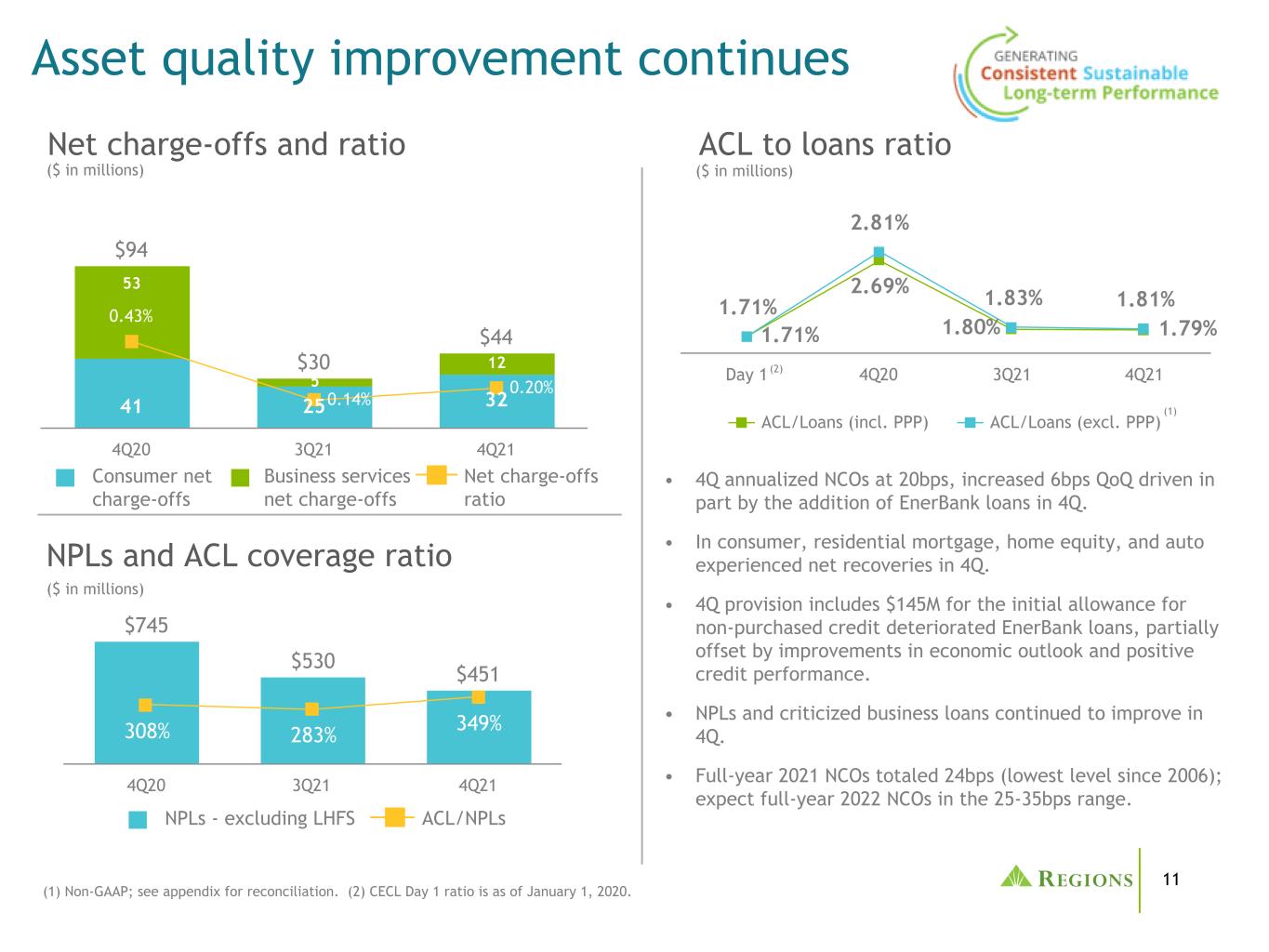
11 1.71% 2.69% 1.80% 1.79% 1.71% 2.81% 1.83% 1.81% ACL/Loans (incl. PPP) ACL/Loans (excl. PPP) Day 1 4Q20 3Q21 4Q21 $94 $30 $44 41 25 32 53 5 12 0.43% 0.14% 0.20% 4Q20 3Q21 4Q21 $745 $530 $451 308% 283% 349% 4Q20 3Q21 4Q21 NPLs and ACL coverage ratio Asset quality improvement continues ($ in millions) ($ in millions) ($ in millions) Net charge-offs and ratio NPLs - excluding LHFS ACL/NPLs Consumer net charge-offs Business services net charge-offs Net charge-offs ratio (1) Non-GAAP; see appendix for reconciliation. (2) CECL Day 1 ratio is as of January 1, 2020. • 4Q annualized NCOs at 20bps, increased 6bps QoQ driven in part by the addition of EnerBank loans in 4Q. • In consumer, residential mortgage, home equity, and auto experienced net recoveries in 4Q. • 4Q provision includes $145M for the initial allowance for non-purchased credit deteriorated EnerBank loans, partially offset by improvements in economic outlook and positive credit performance. • NPLs and criticized business loans continued to improve in 4Q. • Full-year 2021 NCOs totaled 24bps (lowest level since 2006); expect full-year 2022 NCOs in the 25-35bps range. ACL to loans ratio (2) (1)

12 9.8% 10.8% 9.5% 4Q20 3Q21 4Q21 • Common Equity Tier 1 (CET1) ratio decreased 130 bps in 4Q due primarily to non-bank acquisitions and share repurchases. ◦ Continue to prioritize capital utilization for organic growth and non-bank acquisitions that propel future growth. • In 4Q, Regions closed on the acquisitions of EnerBank, Sabal Capital Partners and Clearsight Advisors, which absorbed ~$1.3B of capital combined. • In 4Q, Regions repurchased $300M of common stock and declared $160M in common dividends. • Expect to maintain CET1 near the mid-point of 9.25-9.75% operating range. • Stress Capital Buffer requirement for 4Q21 through 3Q22 is 2.5%. QoQ Highlights & Outlook Capital and liquidity (1) Current quarter ratios are estimated. (2) Based on ending balances. 11.4% 12.3% 11.0% 4Q20 3Q21 4Q21 Tier 1 capital ratio(1) Loan-to-deposit ratio(2) 70% 63% 63% 4Q20 3Q21 4Q21 Common equity Tier 1 ratio(1)
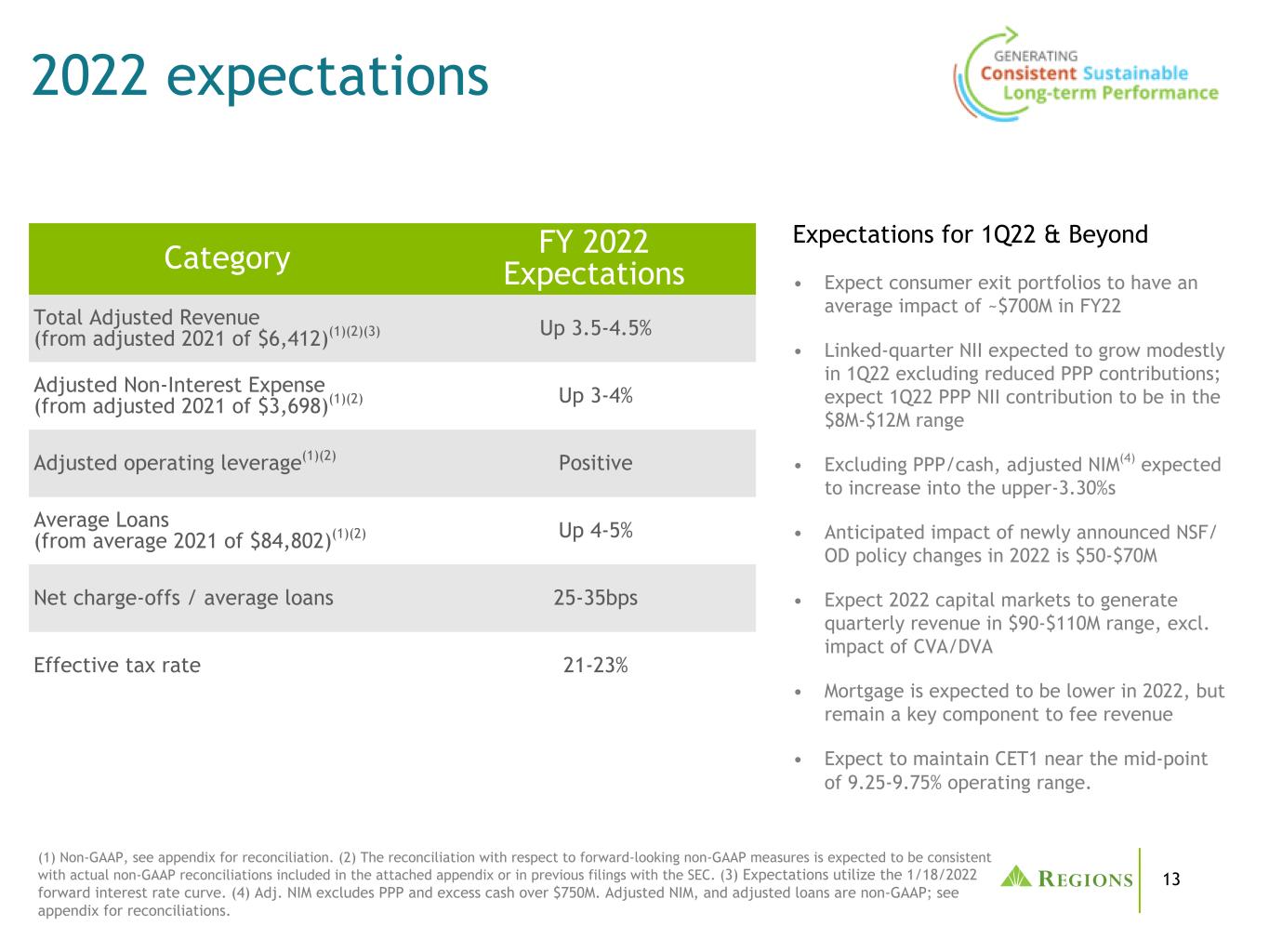
13 2022 expectations (1) Non-GAAP, see appendix for reconciliation. (2) The reconciliation with respect to forward-looking non-GAAP measures is expected to be consistent with actual non-GAAP reconciliations included in the attached appendix or in previous filings with the SEC. (3) Expectations utilize the 1/18/2022 forward interest rate curve. (4) Adj. NIM excludes PPP and excess cash over $750M. Adjusted NIM, and adjusted loans are non-GAAP; see appendix for reconciliations. Category FY 2022 Expectations Total Adjusted Revenue (from adjusted 2021 of $6,412)(1)(2)(3) Up 3.5-4.5% Adjusted Non-Interest Expense (from adjusted 2021 of $3,698)(1)(2) Up 3-4% Adjusted operating leverage(1)(2) Positive Average Loans (from average 2021 of $84,802)(1)(2) Up 4-5% Net charge-offs / average loans 25-35bps Effective tax rate 21-23% Expectations for 1Q22 & Beyond • Expect consumer exit portfolios to have an average impact of ~$700M in FY22 • Linked-quarter NII expected to grow modestly in 1Q22 excluding reduced PPP contributions; expect 1Q22 PPP NII contribution to be in the $8M-$12M range • Excluding PPP/cash, adjusted NIM(4) expected to increase into the upper-3.30%s • Anticipated impact of newly announced NSF/ OD policy changes in 2022 is $50-$70M • Expect 2022 capital markets to generate quarterly revenue in $90-$110M range, excl. impact of CVA/DVA • Mortgage is expected to be lower in 2022, but remain a key component to fee revenue • Expect to maintain CET1 near the mid-point of 9.25-9.75% operating range.
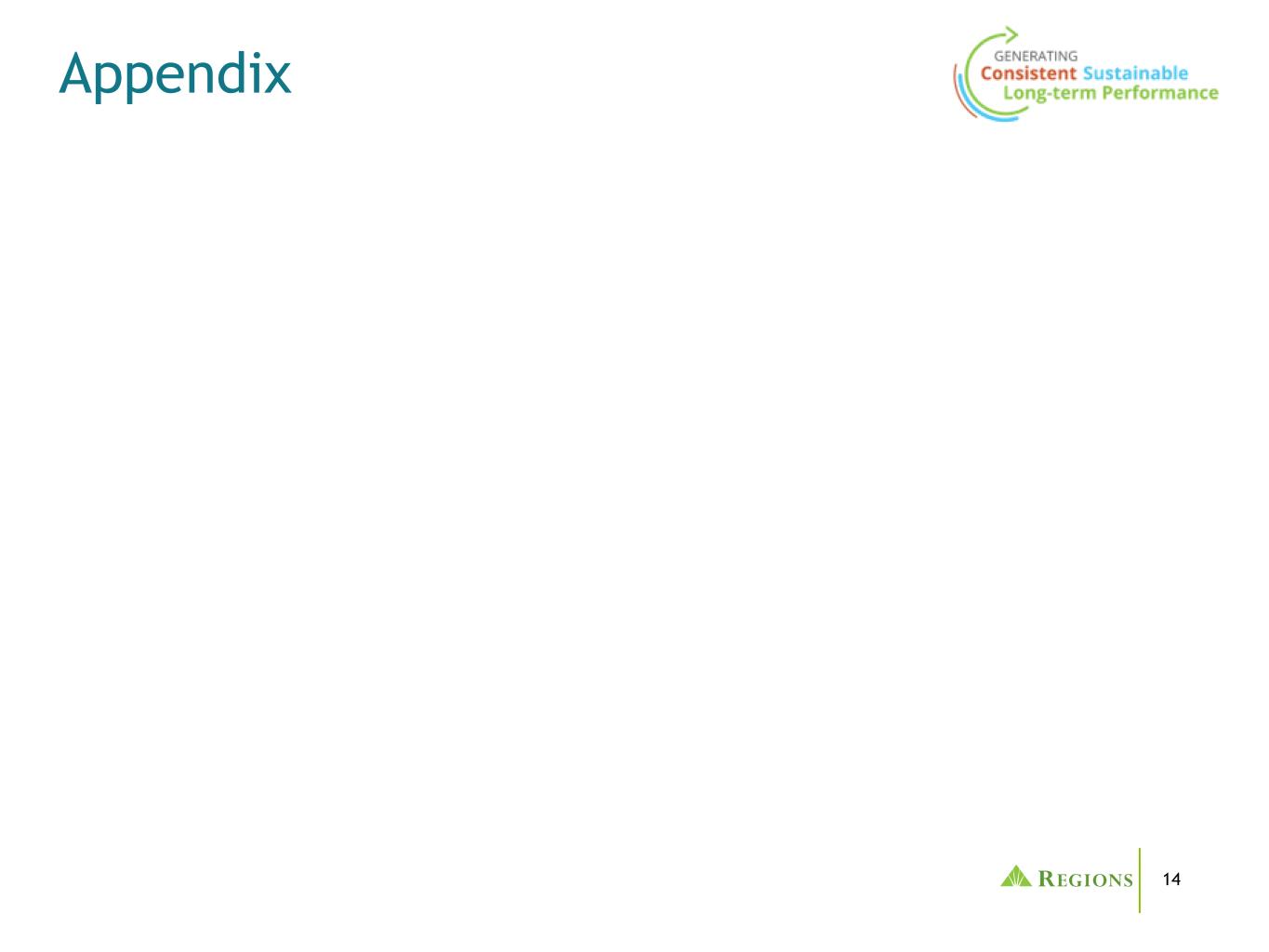
14 Appendix
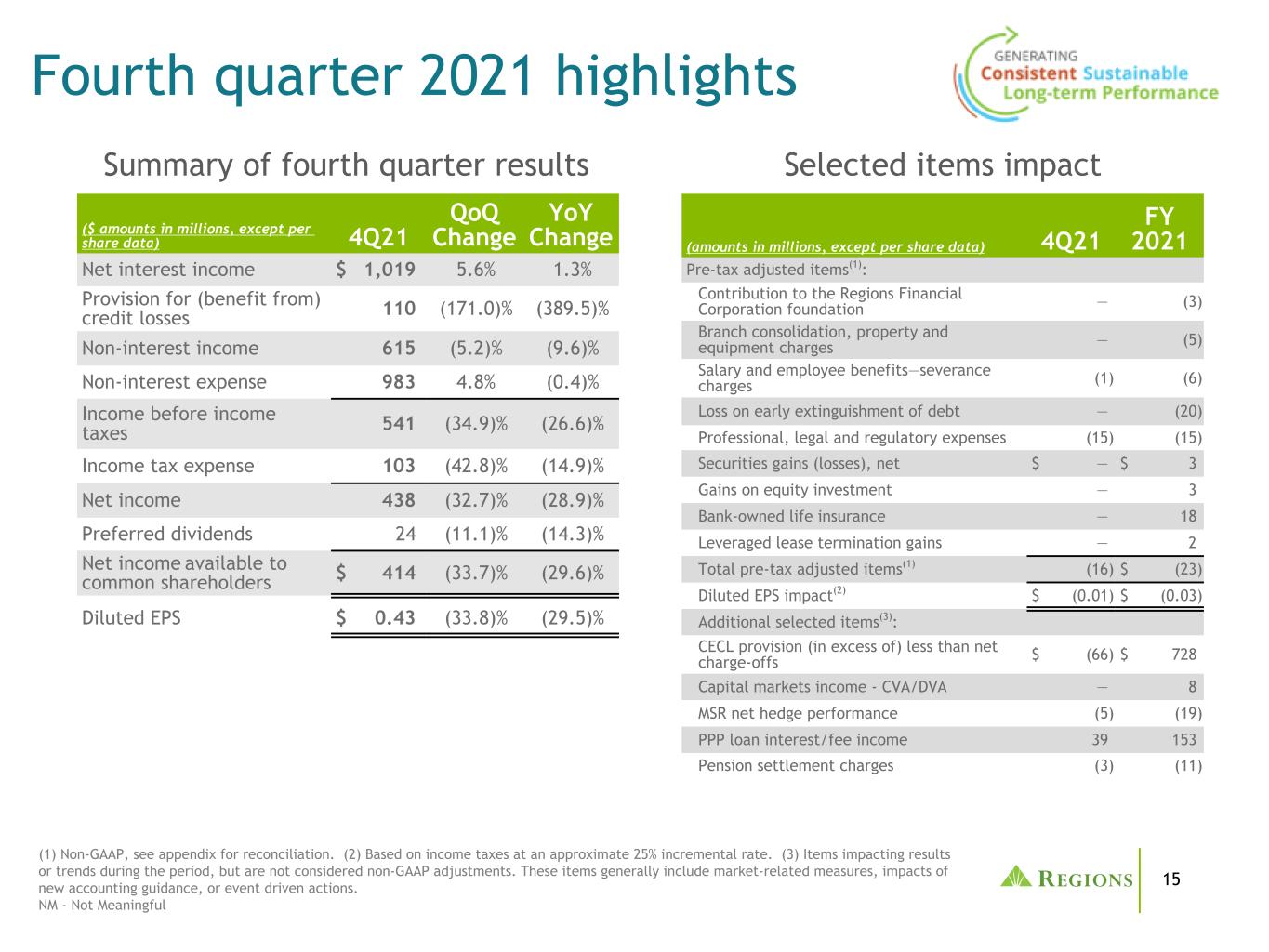
15 Selected items impact Fourth quarter 2021 highlights (1) Non-GAAP, see appendix for reconciliation. (2) Based on income taxes at an approximate 25% incremental rate. (3) Items impacting results or trends during the period, but are not considered non-GAAP adjustments. These items generally include market-related measures, impacts of new accounting guidance, or event driven actions. NM - Not Meaningful ($ amounts in millions, except per share data) 4Q21 QoQ Change YoY Change Net interest income $ 1,019 5.6% 1.3% Provision for (benefit from) credit losses 110 (171.0)% (389.5)% Non-interest income 615 (5.2)% (9.6)% Non-interest expense 983 4.8% (0.4)% Income before income taxes 541 (34.9)% (26.6)% Income tax expense 103 (42.8)% (14.9)% Net income 438 (32.7)% (28.9)% Preferred dividends 24 (11.1)% (14.3)% Net income available to common shareholders $ 414 (33.7)% (29.6)% Diluted EPS $ 0.43 (33.8)% (29.5)% Summary of fourth quarter results (amounts in millions, except per share data) 4Q21 FY 2021 Pre-tax adjusted items(1): Contribution to the Regions Financial Corporation foundation — (3) Branch consolidation, property and equipment charges — (5) Salary and employee benefits—severance charges (1) (6) Loss on early extinguishment of debt — (20) Professional, legal and regulatory expenses (15) (15) Securities gains (losses), net $ — $ 3 Gains on equity investment — 3 Bank-owned life insurance — 18 Leveraged lease termination gains — 2 Total pre-tax adjusted items(1) (16) $ (23) Diluted EPS impact(2) $ (0.01) $ (0.03) Additional selected items(3): CECL provision (in excess of) less than net charge-offs $ (66) $ 728 Capital markets income - CVA/DVA — 8 MSR net hedge performance (5) (19) PPP loan interest/fee income 39 153 Pension settlement charges (3) (11)

16 Regions has made significant changes and upgrades while continuing to provide clients with resources needed to succeed in managing their finances. Details of Regions' Announcement(2): • By end of 1Q22-Eliminate overdraft protection transfer fees • By end of 2Q22-Reduce daily cap for overdraft occurrences to 3 • By end of 2Q22-Eliminate all NSF fees • By end of 3Q22-Early access to direct deposit • By end of 3Q22-Small dollar LOC available for qualifying customers Deposit account announcement Providing customers capabilities to be more financially sound Updated NSF/OD Policies $2,109 $2,498 2011 2012 2013 2014 2015 2016 2017 2018 2019 2020 2021 Adjusted Non-Interest Income(1) • NSF/OD fees have declined ~$175M since 2011 while total adjusted NIR increased ~$400M over that same time period by growing & diversifying revenue through expanded fee-based services including: ◦ Mortgage ◦ Capital markets ◦ Wealth management ◦ Card & ATM • Once implemented, annual NSF/OD revenue is anticipated to be ~50% below 2011 levels • Regulation E and debit interchange legislation had a combined $300M negative impact on Regions' fee income Regions is committed to making banking easier for our customers. • Bank On certified Now Checking account • Simplified transaction posting order • Reduced fees • Customer education tools • Expansion of alert capabilities • Enhanced available balance views in digital channels • Intraday visibility of checks cleared Enhancements Product Features (1) Non-GAAP; see appendix for reconciliation. (2) For specific account details and eligibility requirements see "Regions Bank Announces New Steps to Reduce Overdraft Charges, Eliminate Non-Sufficient Funds Fees" press release dated January 19, 2022. ($ in millions)
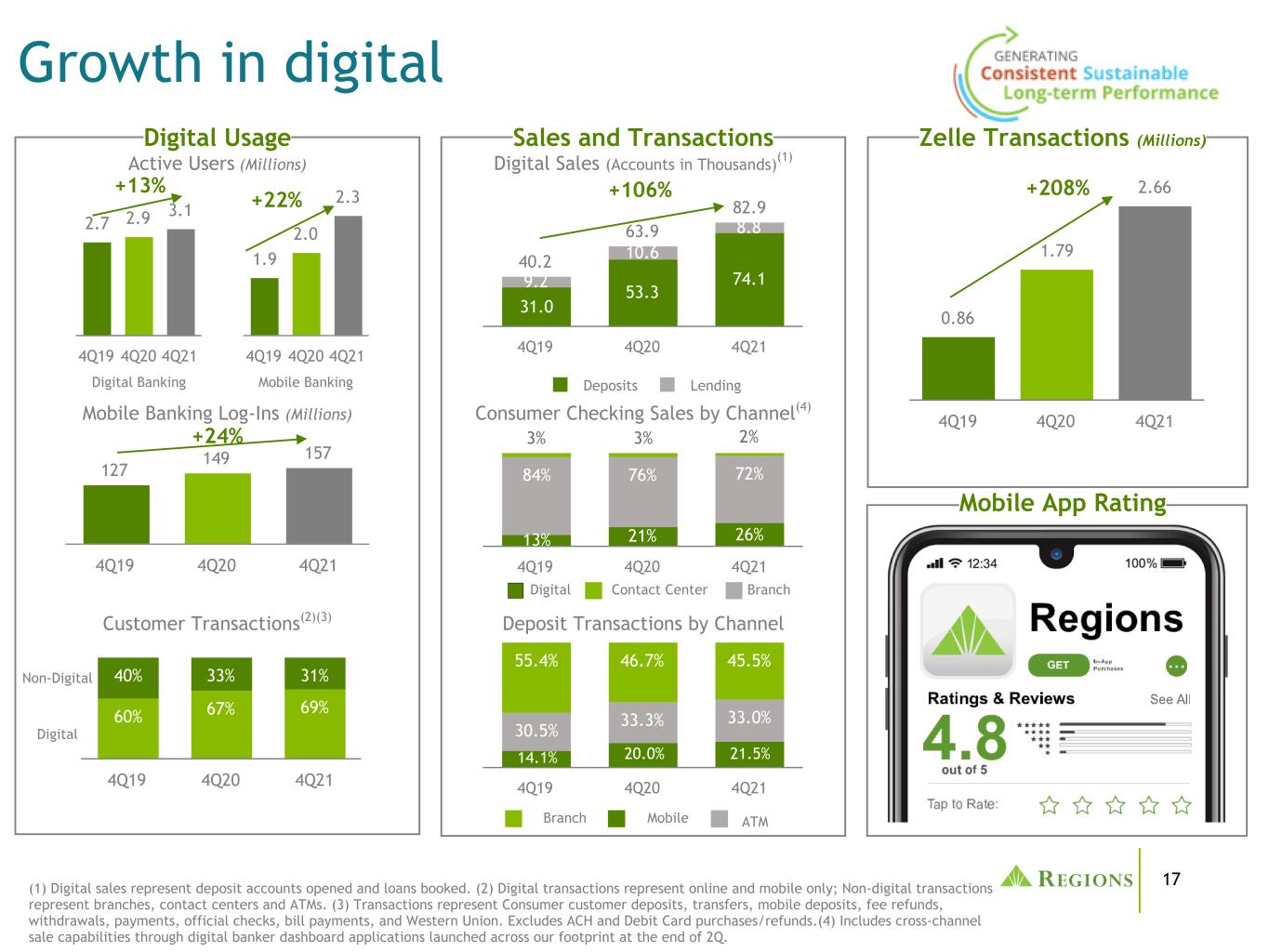
17 1.9 2.0 2.3 4Q19 4Q20 4Q21 0.86 1.79 2.66 4Q19 4Q20 4Q21 127 149 157 4Q19 4Q20 4Q21 2.7 2.9 3.1 4Q19 4Q20 4Q21 14.1% 20.0% 21.5% 30.5% 33.3% 33.0% 55.4% 46.7% 45.5% 4Q19 4Q20 4Q21 40.2 63.9 82.9 31.0 53.3 74.19.2 10.6 8.8 Deposits Lending 4Q19 4Q20 4Q21 60% 67% 69% 40% 33% 31% 4Q19 4Q20 4Q21 Growth in digital Mobile Banking Log-Ins (Millions) Customer Transactions(2)(3) Deposit Transactions by Channel +13% Active Users (Millions) +22% Digital Sales (Accounts in Thousands)(1) Digital Banking Digital Non-Digital Mobile ATMBranch (1) Digital sales represent deposit accounts opened and loans booked. (2) Digital transactions represent online and mobile only; Non-digital transactions represent branches, contact centers and ATMs. (3) Transactions represent Consumer customer deposits, transfers, mobile deposits, fee refunds, withdrawals, payments, official checks, bill payments, and Western Union. Excludes ACH and Debit Card purchases/refunds.(4) Includes cross-channel sale capabilities through digital banker dashboard applications launched across our footprint at the end of 2Q. +208% +24% 13% 21% 26% 84% 76% 72% 3% 3% 2% 4Q19 4Q20 4Q21 Digital BranchContact Center Consumer Checking Sales by Channel(4) Mobile Banking Mobile App Rating Zelle Transactions (Millions)Sales and TransactionsDigital Usage +106%

18 Borrowings/ Other(1) 2017 2021 Deposit advantage (1) "Other" category includes EnerBank deposits. (2) Source - Bank Call Report data as of 09/30/2021. (3) 4Q2021 Average NIB/IB split by Business: Consumer 37%/63%, Corporate 61%/39%, Wealth 15%/85%. Funding Mix - Current vs. Prior Rising Rate Cycle • Regions holds a larger proportion of smaller deposit balance accounts when compared to the industry • The increase in consumer deposits has been largely with existing long-tenure customers, whose low rate sensitivity is likely to persist into the next rate cycle 64% 57% 50% 44% 44% 43% 42% 42% 41% 38% 37% 35% 27% Peer 1 Peer 2 RF Peer 3 Peer 4 Peer 5 Peer 6 Peer 7 Peer 8 Peer 9 Peer 10 Peer 11 Peer 12 % of Total Deposits Balance in Accounts Less than $250k(2) Business Deposit Mix 4Q 2021 Average Consumer $81 Corporate $43 Wealth Mgt $10 Other $3 Product Mix Deposit Granularity • Historically, Regions deposit pricing has outperformed peer banks in rising rate environment; in last rising interest rate cycle, Regions total interest bearing deposit betas of 29% (retail 14%; commercial 67%); outperformed the peer median of 35% • The funding mix has become more granular and less reliant on wholesale borrowings, positioning the balance sheet well for a potential rising rate environment • Balance sheet primarily deposit funded; 96% of liabilities; 6% higher than at the outset of the last up-rate cycle • 42% of deposit balances in non-interest bearing accounts(3) • Retail deposits consist of consumer and wealth accounts and represent 67% of total deposits Well Positioned for Rising Rates 30% 64% 62% 26% 12% 6% $107 $142 Retail Commercial (1) ($ in billions) (1) ($ in billions)
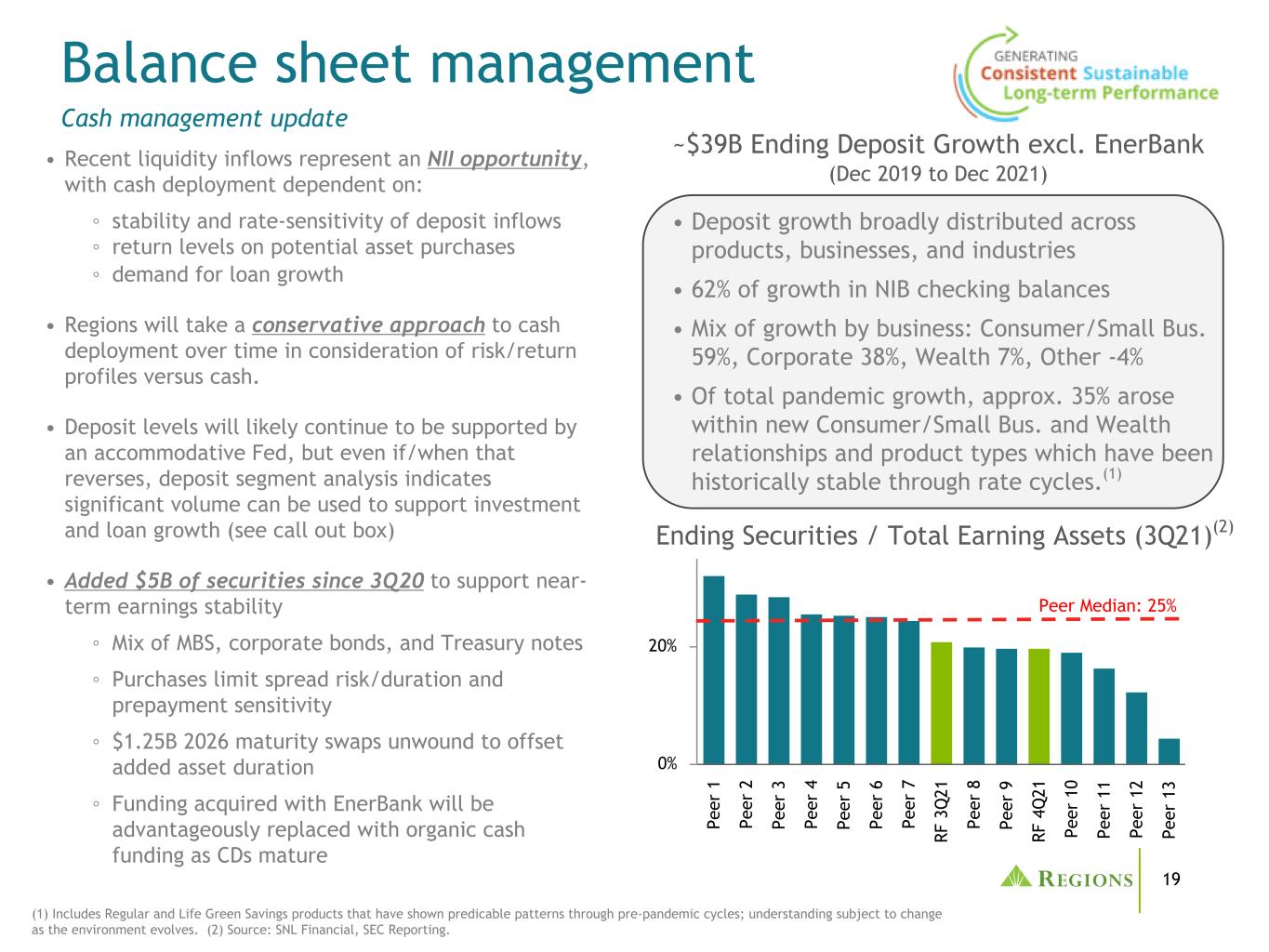
19 Pe er 1 Pe er 2 Pe er 3 Pe er 4 Pe er 5 Pe er 6 Pe er 7 RF 3 Q 21 Pe er 8 Pe er 9 RF 4 Q 21 Pe er 1 0 Pe er 1 1 Pe er 1 2 Pe er 1 3 0% 20% Peer Median: 25% Ending Securities / Total Earning Assets (3Q21)(2) • Recent liquidity inflows represent an NII opportunity, with cash deployment dependent on: ◦ stability and rate-sensitivity of deposit inflows ◦ return levels on potential asset purchases ◦ demand for loan growth • Regions will take a conservative approach to cash deployment over time in consideration of risk/return profiles versus cash. • Deposit levels will likely continue to be supported by an accommodative Fed, but even if/when that reverses, deposit segment analysis indicates significant volume can be used to support investment and loan growth (see call out box) • Added $5B of securities since 3Q20 to support near- term earnings stability ◦ Mix of MBS, corporate bonds, and Treasury notes ◦ Purchases limit spread risk/duration and prepayment sensitivity ◦ $1.25B 2026 maturity swaps unwound to offset added asset duration ◦ Funding acquired with EnerBank will be advantageously replaced with organic cash funding as CDs mature (1) Includes Regular and Life Green Savings products that have shown predicable patterns through pre-pandemic cycles; understanding subject to change as the environment evolves. (2) Source: SNL Financial, SEC Reporting. ~$39B Ending Deposit Growth excl. EnerBank (Dec 2019 to Dec 2021) Balance sheet management Cash management update • Deposit growth broadly distributed across products, businesses, and industries • 62% of growth in NIB checking balances • Mix of growth by business: Consumer/Small Bus. 59%, Corporate 38%, Wealth 7%, Other -4% • Of total pandemic growth, approx. 35% arose within new Consumer/Small Bus. and Wealth relationships and product types which have been historically stable through rate cycles.(1)
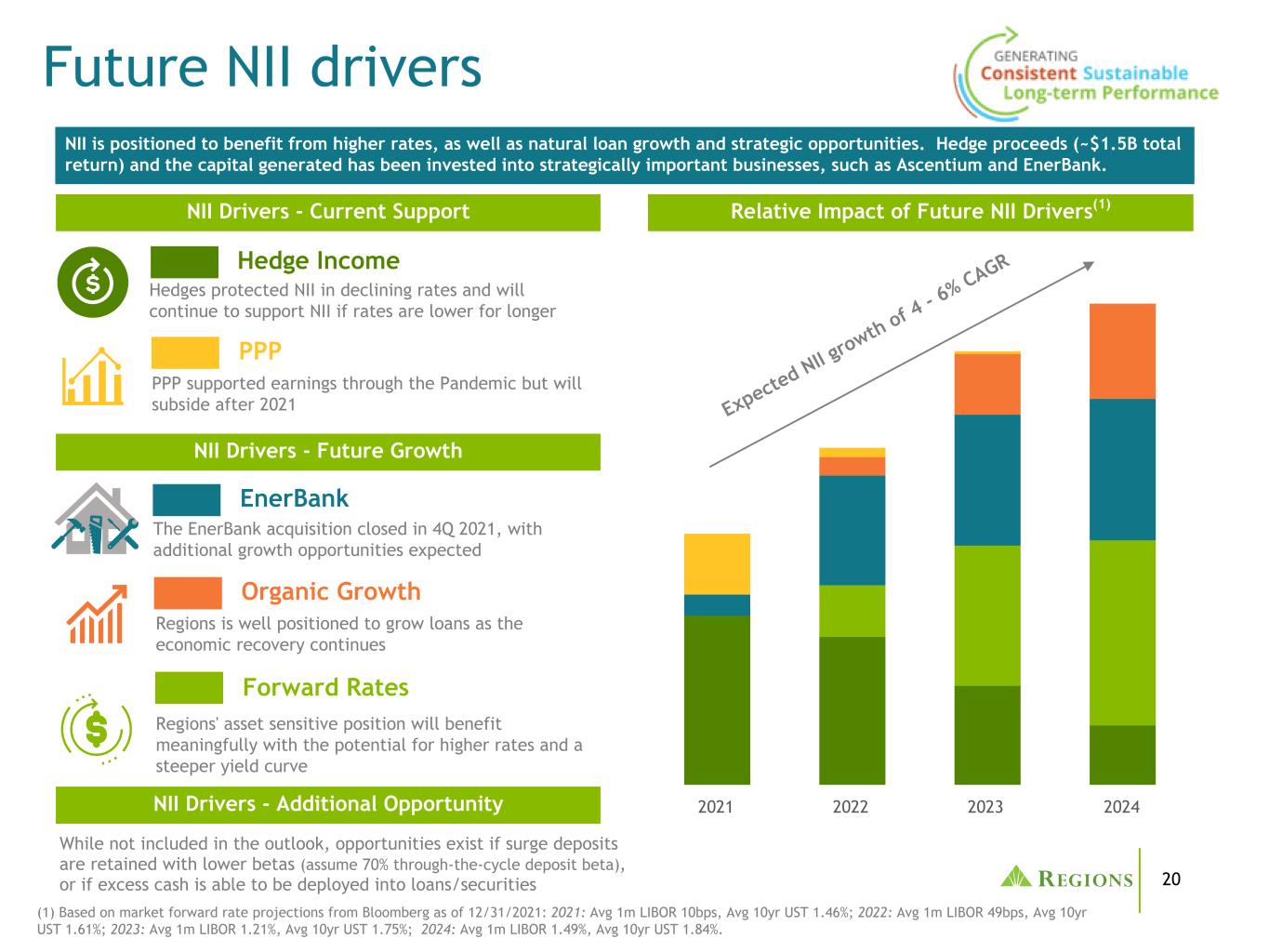
20 While not included in the outlook, opportunities exist if surge deposits are retained with lower betas (assume 70% through-the-cycle deposit beta), or if excess cash is able to be deployed into loans/securities NII is positioned to benefit from higher rates, as well as natural loan growth and strategic opportunities. Hedge proceeds (~$1.5B total return) and the capital generated has been invested into strategically important businesses, such as Ascentium and EnerBank. 2021 2022 2023 2024 NII Drivers - Current Support Relative Impact of Future NII Drivers(1) NII Drivers - Future Growth Expecte d NII g rowth of 4 - 6 % CAGRHedge Income Forward Rates EnerBank PPP Organic Growth Hedges protected NII in declining rates and will continue to support NII if rates are lower for longer Regions' asset sensitive position will benefit meaningfully with the potential for higher rates and a steeper yield curve The EnerBank acquisition closed in 4Q 2021, with additional growth opportunities expected PPP supported earnings through the Pandemic but will subside after 2021 Regions is well positioned to grow loans as the economic recovery continues NII Drivers - Additional Opportunity (1) Based on market forward rate projections from Bloomberg as of 12/31/2021: 2021: Avg 1m LIBOR 10bps, Avg 10yr UST 1.46%; 2022: Avg 1m LIBOR 49bps, Avg 10yr UST 1.61%; 2023: Avg 1m LIBOR 1.21%, Avg 10yr UST 1.75%; 2024: Avg 1m LIBOR 1.49%, Avg 10yr UST 1.84%. Future NII drivers
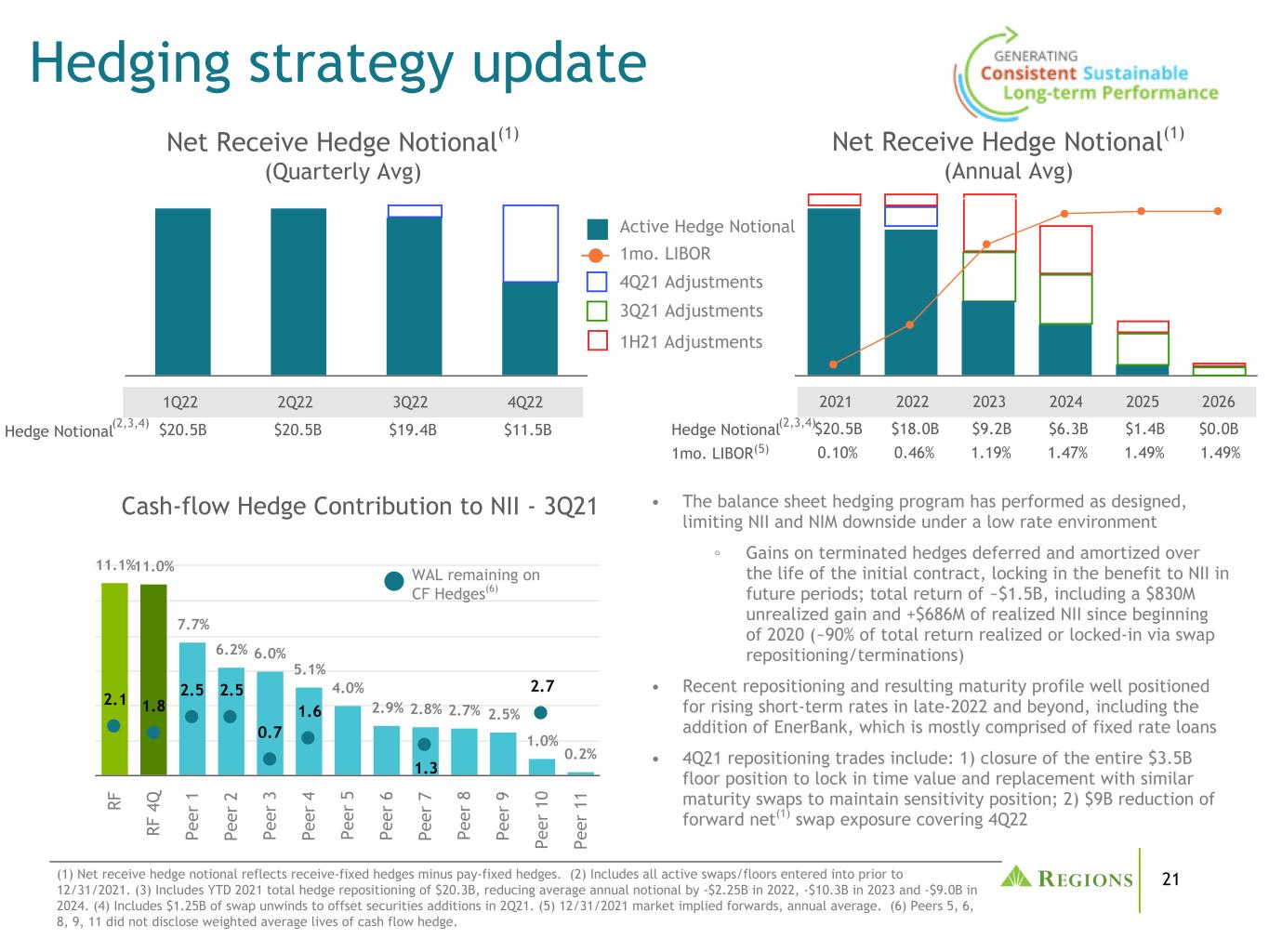
21 • The balance sheet hedging program has performed as designed, limiting NII and NIM downside under a low rate environment ◦ Gains on terminated hedges deferred and amortized over the life of the initial contract, locking in the benefit to NII in future periods; total return of ~$1.5B, including a $830M unrealized gain and +$686M of realized NII since beginning of 2020 (~90% of total return realized or locked-in via swap repositioning/terminations) • Recent repositioning and resulting maturity profile well positioned for rising short-term rates in late-2022 and beyond, including the addition of EnerBank, which is mostly comprised of fixed rate loans • 4Q21 repositioning trades include: 1) closure of the entire $3.5B floor position to lock in time value and replacement with similar maturity swaps to maintain sensitivity position; 2) $9B reduction of forward net(1) swap exposure covering 4Q22 1 2 3 4 5 6 Net Receive Hedge Notional(1) (Annual Avg) 2021 2022 2023 2024 2025 2026 Hedge Notional $20.5B $18.0B $9.2B $6.3B $1.4B $0.0B 1mo. LIBOR 0.10% 0.46% 1.19% 1.47% 1.49% 1.49% (2,3,4) (5) 1 2 3 41Q22 2Q22 3Q22 4Q22 Hedge Notional $20.5B $20.5B $19.4B $11.5B 11.1%11.0% 7.7% 6.2% 6.0% 5.1% 4.0% 2.9% 2.8% 2.7% 2.5% 1.0% 0.2% 2.1 1.8 2.5 2.5 0.7 1.6 1.3 2.7 RF RF 4 Q Pe er 1 Pe er 2 Pe er 3 Pe er 4 Pe er 5 Pe er 6 Pe er 7 Pe er 8 Pe er 9 Pe er 1 0 Pe er 1 1 (1) Net receive hedge notional reflects receive-fixed hedges minus pay-fixed hedges. (2) Includes all active swaps/floors entered into prior to 12/31/2021. (3) Includes YTD 2021 total hedge repositioning of $20.3B, reducing average annual notional by -$2.25B in 2022, -$10.3B in 2023 and -$9.0B in 2024. (4) Includes $1.25B of swap unwinds to offset securities additions in 2Q21. (5) 12/31/2021 market implied forwards, annual average. (6) Peers 5, 6, 8, 9, 11 did not disclose weighted average lives of cash flow hedge. Hedging strategy update Cash-flow Hedge Contribution to NII - 3Q21 WAL remaining on CF Hedges(6) Net Receive Hedge Notional(1) (Quarterly Avg) (2,3,4) 1mo. LIBOR Active Hedge Notional 3Q21 Adjustments 4Q21 Adjustments 1H21 Adjustments
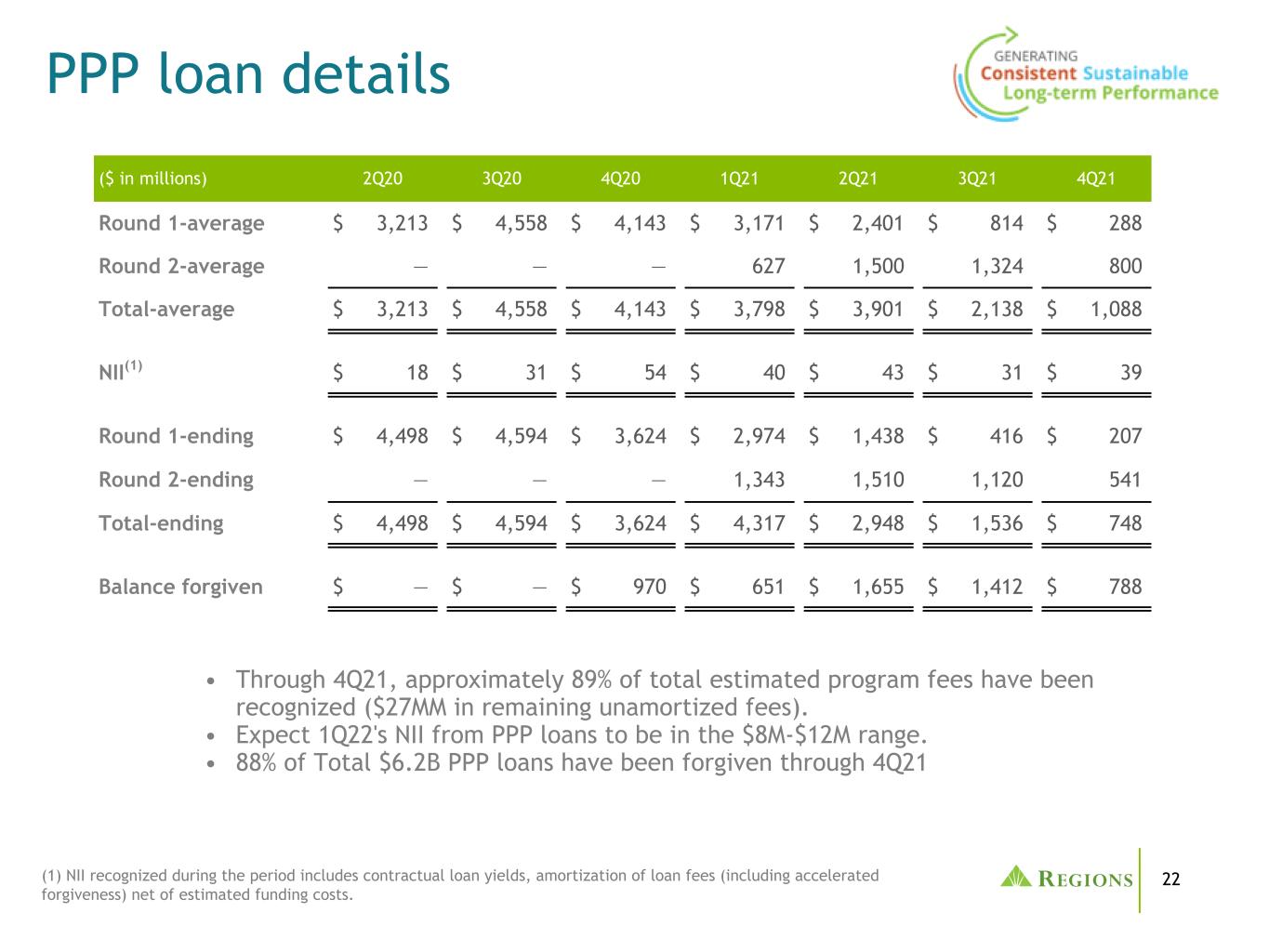
22 ($ in millions) 2Q20 3Q20 4Q20 1Q21 2Q21 3Q21 4Q21 Round 1-average $ 3,213 $ 4,558 $ 4,143 $ 3,171 $ 2,401 $ 814 $ 288 Round 2-average — — — 627 1,500 1,324 800 Total-average $ 3,213 $ 4,558 $ 4,143 $ 3,798 $ 3,901 $ 2,138 $ 1,088 NII(1) $ 18 $ 31 $ 54 $ 40 $ 43 $ 31 $ 39 Round 1-ending $ 4,498 $ 4,594 $ 3,624 $ 2,974 $ 1,438 $ 416 $ 207 Round 2-ending — — — 1,343 1,510 1,120 541 Total-ending $ 4,498 $ 4,594 $ 3,624 $ 4,317 $ 2,948 $ 1,536 $ 748 Balance forgiven $ — $ — $ 970 $ 651 $ 1,655 $ 1,412 $ 788 PPP loan details • Through 4Q21, approximately 89% of total estimated program fees have been recognized ($27MM in remaining unamortized fees). • Expect 1Q22's NII from PPP loans to be in the $8M-$12M range. • 88% of Total $6.2B PPP loans have been forgiven through 4Q21 (1) NII recognized during the period includes contractual loan yields, amortization of loan fees (including accelerated forgiveness) net of estimated funding costs.
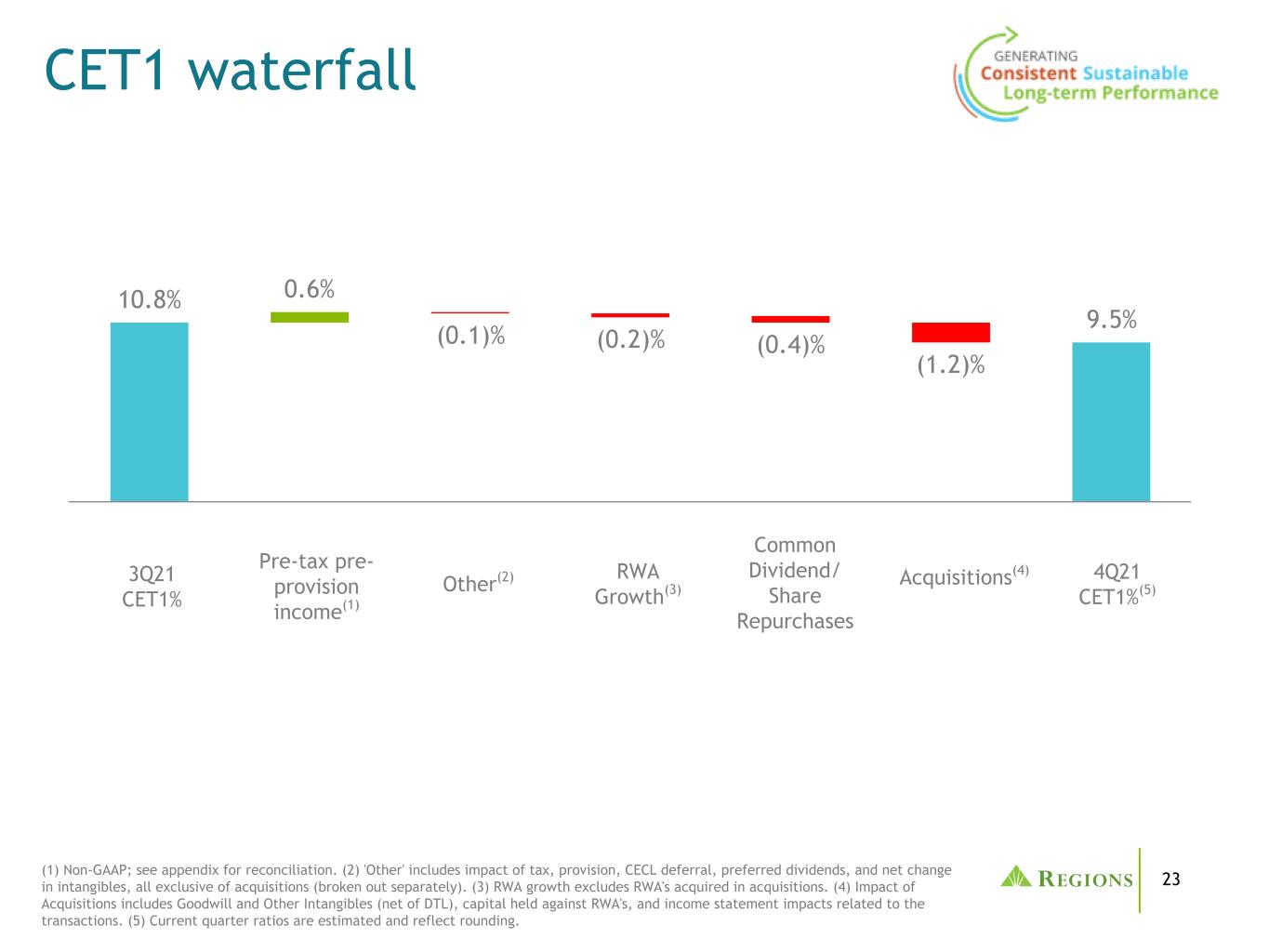
23 10.8% 0.6% (0.1)% (0.2)% (0.4)% (1.2)% 9.5% CET1 waterfall (1) Non-GAAP; see appendix for reconciliation. (2) 'Other' includes impact of tax, provision, CECL deferral, preferred dividends, and net change in intangibles, all exclusive of acquisitions (broken out separately). (3) RWA growth excludes RWA's acquired in acquisitions. (4) Impact of Acquisitions includes Goodwill and Other Intangibles (net of DTL), capital held against RWA's, and income statement impacts related to the transactions. (5) Current quarter ratios are estimated and reflect rounding. 3Q21 CET1% Pre-tax pre- provision income(1) Other(2) 4Q21 CET1%(5) Common Dividend/ Share Repurchases Acquisitions(4)RWA Growth(3)

24 Changes in Portfolio Risk & Balances $1,499 $(44) $(51) $2 $168 $1,574 Allowance for credit losses waterfall Changes in Economic Outlook & Adjustments Net Charge- Offs 12/31/2021 • 4Q ending allowance, excluding EnerBank, decreased $93M due to continued improvement in the economic outlook and expectations of improving credit performance in certain sectors / clients. • The benefits of the improving economic outlook were partially offset by a continued level of imprecision due to uncertainty regarding recurring virus variants, lingering supply chain issues, and inflation that is now considered persistent. • Including EnerBank, the 4Q ending allowance increased $75M. QoQ highlights ($ in millions) 09/30/2021 EnerBank

25 Pre-R&S period 4Q2021 1Q2022 2Q2022 3Q2022 4Q2022 1Q2023 2Q2023 3Q2023 4Q2023 Real GDP, annualized % change 6.4 % 4.0 % 4.2 % 4.0 % 3.4 % 2.6 % 2.2 % 2.1 % 2.2 % Unemployment rate 4.4 % 3.9 % 3.8 % 3.7 % 3.7 % 3.6 % 3.6 % 3.5 % 3.5 % HPI, year-over-year % change 16.7 % 14.0 % 9.6 % 6.0 % 4.7 % 4.7 % 4.7 % 4.5 % 4.2 % S&P 500 4,570 4,643 4,697 4,760 4,833 4,892 4,940 4,987 5,036 Base R&S economic outlook (as of December 2021) • Economic forecasts represent Regions’ internal outlook for the economy over the reasonable & supportable forecast period. • Given improvements in the economic outlook, management considered alternative analytics to support qualitative additions to the modeled results to reflect continued risk and uncertainty in certain portfolios.
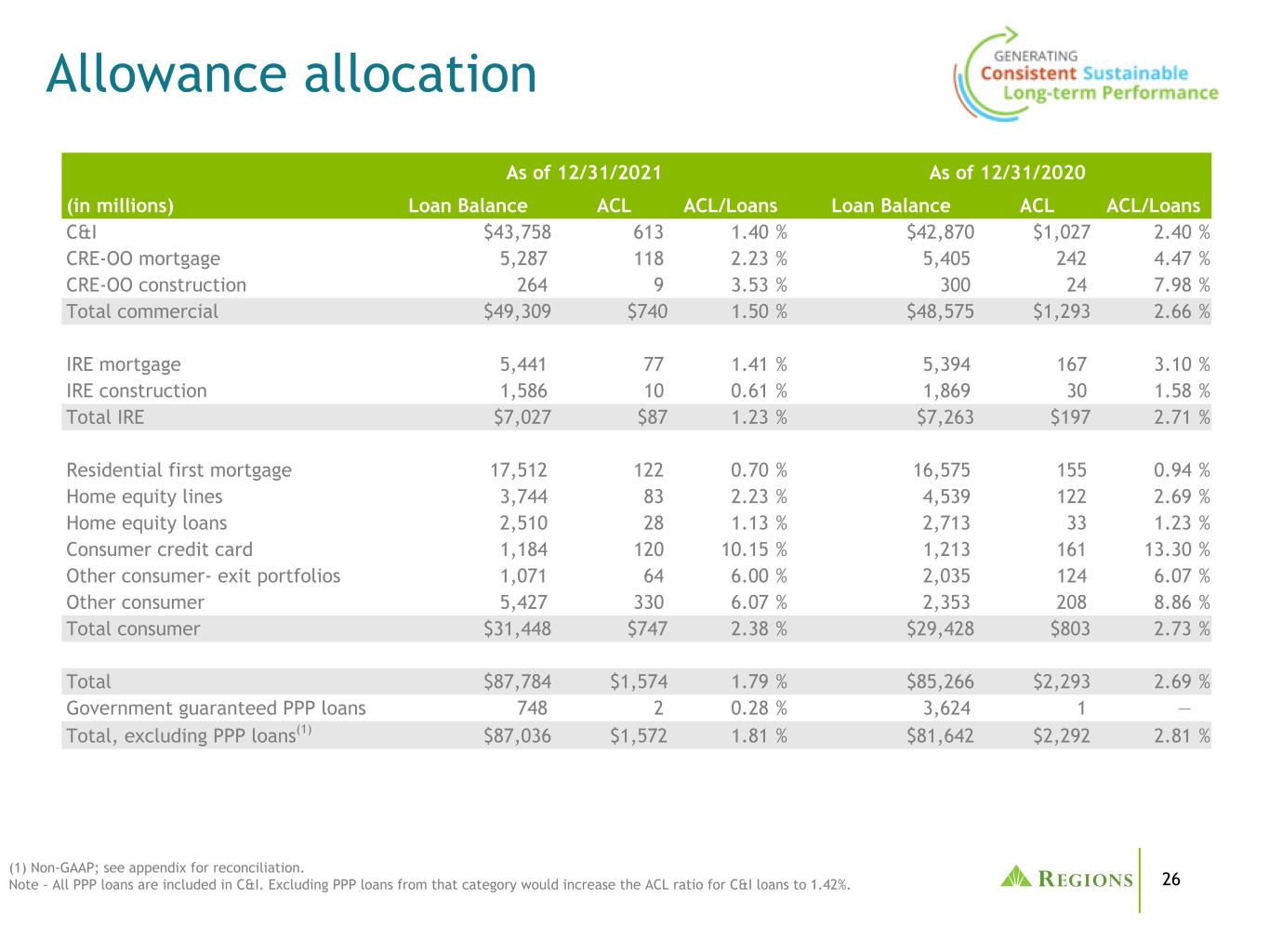
26 As of 12/31/2021 As of 12/31/2020 (in millions) Loan Balance ACL ACL/Loans Loan Balance ACL ACL/Loans C&I $43,758 613 1.40 % $42,870 $1,027 2.40 % CRE-OO mortgage 5,287 118 2.23 % 5,405 242 4.47 % CRE-OO construction 264 9 3.53 % 300 24 7.98 % Total commercial $49,309 $740 1.50 % $48,575 $1,293 2.66 % IRE mortgage 5,441 77 1.41 % 5,394 167 3.10 % IRE construction 1,586 10 0.61 % 1,869 30 1.58 % Total IRE $7,027 $87 1.23 % $7,263 $197 2.71 % Residential first mortgage 17,512 122 0.70 % 16,575 155 0.94 % Home equity lines 3,744 83 2.23 % 4,539 122 2.69 % Home equity loans 2,510 28 1.13 % 2,713 33 1.23 % Consumer credit card 1,184 120 10.15 % 1,213 161 13.30 % Other consumer- exit portfolios 1,071 64 6.00 % 2,035 124 6.07 % Other consumer 5,427 330 6.07 % 2,353 208 8.86 % Total consumer $31,448 $747 2.38 % $29,428 $803 2.73 % Total $87,784 $1,574 1.79 % $85,266 $2,293 2.69 % Government guaranteed PPP loans 748 2 0.28 % 3,624 1 — Total, excluding PPP loans(1) $87,036 $1,572 1.81 % $81,642 $2,292 2.81 % Allowance allocation (1) Non-GAAP; see appendix for reconciliation. Note - All PPP loans are included in C&I. Excluding PPP loans from that category would increase the ACL ratio for C&I loans to 1.42%.

27 Ascentium Capital acquisition Acquisition exceeding expectations Company Overview • Ascentium Capital was the largest independent equipment finance lender in the U.S. • Partners with ~4,000 vendors to finance essential-use equipment for small business customers. • Strong risk management culture and data driven framework resulting in solid credit performance throughout economic cycles. • Provides diversification with strength across multiple industries and geographies. Integration Updates Ascentium Financial Performance(1) • Ascentium Capital has contributed 10% of the Corporate Banking Group's YTD total revenue. • Loan production increased 8% YoY.(2) • Recoveries remain historically high; delinquencies and NCOs remain below pre-pandemic levels. Acquisition closed April 1, 2020, and integration with Regions' systems, policies and people is now complete. Ascentium provided payment relief to as much as 30% of its customers at the peak of the pandemic; currently no customers remain on a relief plan. Transportation & Warehousing 32% Healthcare 12% Restaurant, Accommodation & Lodging 11% Real Estate - Services, Construction 9% Administrative, Support 8% Retail Trade 7% Manufacturing 7% All Other 14% Industry Diversification(1) Ascentium focus on portfolio growth in areas of core strength. Cross-sell of products between Ascentium & Regions customers has begun. Differentiated technology platform and processes, delivering same day credit decisions and funding. (1) Ascentium loan balances were ~$2.1B at 12/31/2021 (excludes HFS). (2) 4Q21 vs. 4Q20.
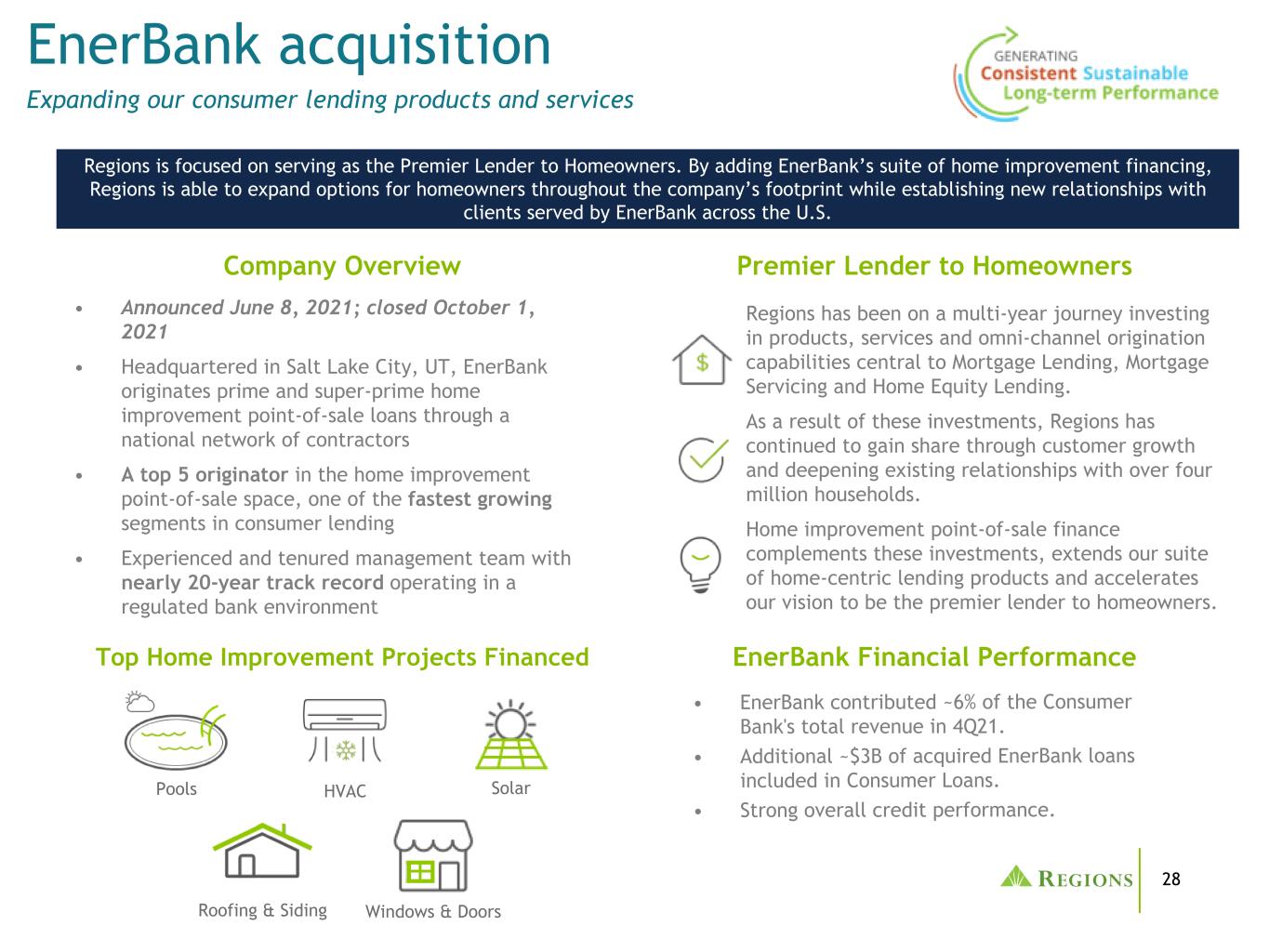
28 • Announced June 8, 2021; closed October 1, 2021 • Headquartered in Salt Lake City, UT, EnerBank originates prime and super-prime home improvement point-of-sale loans through a national network of contractors • A top 5 originator in the home improvement point-of-sale space, one of the fastest growing segments in consumer lending • Experienced and tenured management team with nearly 20-year track record operating in a regulated bank environment Company Overview Top Home Improvement Projects Financed Roofing & Siding Windows & Doors Pools HVAC Solar EnerBank Financial Performance • EnerBank contributed ~6% of the Consumer Bank's total revenue in 4Q21. • Additional ~$3B of acquired EnerBank loans included in Consumer Loans. • Strong overall credit performance. Premier Lender to Homeowners Regions has been on a multi-year journey investing in products, services and omni-channel origination capabilities central to Mortgage Lending, Mortgage Servicing and Home Equity Lending. As a result of these investments, Regions has continued to gain share through customer growth and deepening existing relationships with over four million households. Home improvement point-of-sale finance complements these investments, extends our suite of home-centric lending products and accelerates our vision to be the premier lender to homeowners. Regions is focused on serving as the Premier Lender to Homeowners. By adding EnerBank’s suite of home improvement financing, Regions is able to expand options for homeowners throughout the company’s footprint while establishing new relationships with clients served by EnerBank across the U.S. EnerBank acquisition Expanding our consumer lending products and services
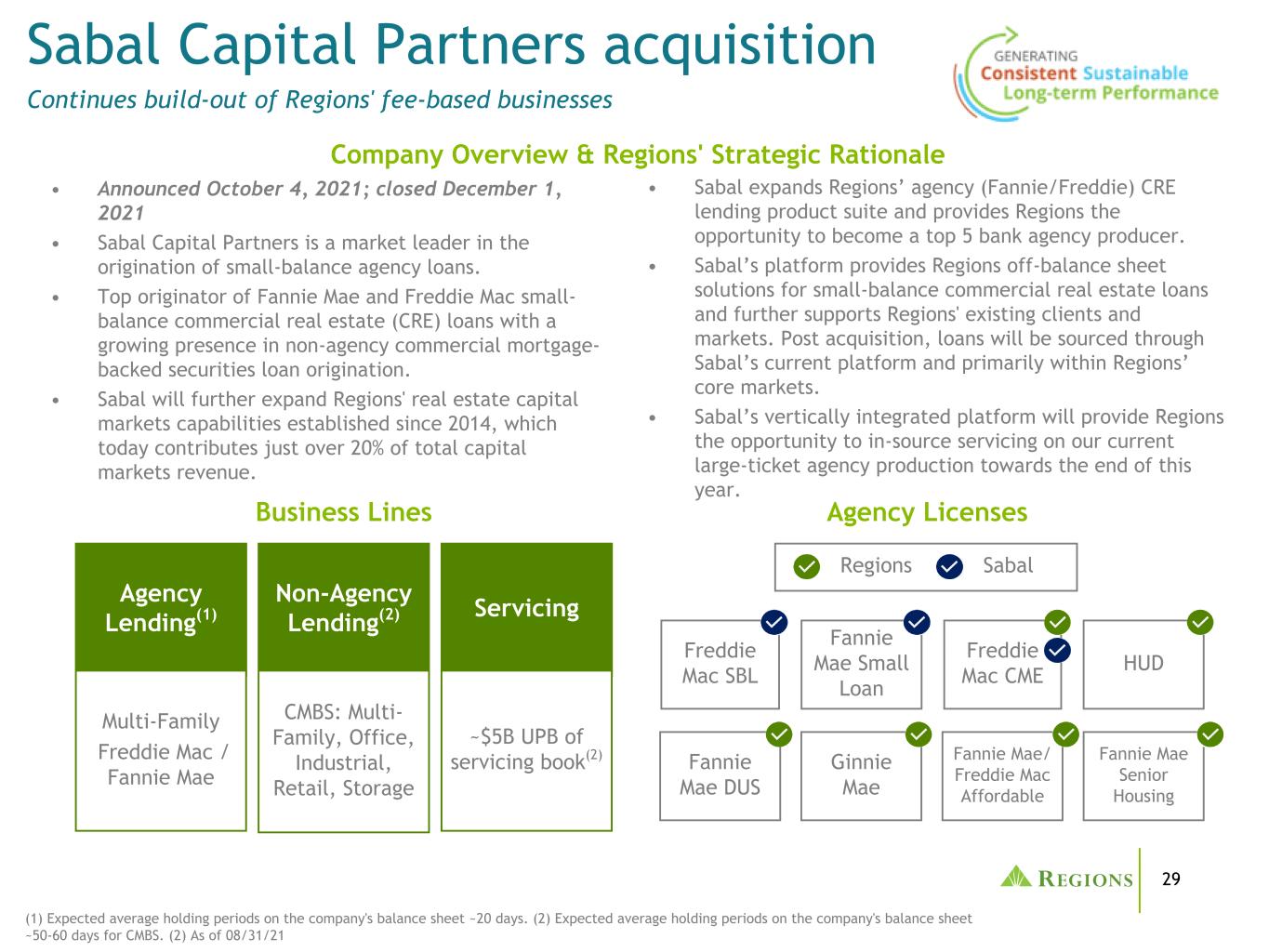
29 Agency Licenses Sabal Capital Partners acquisition Continues build-out of Regions' fee-based businesses Company Overview & Regions' Strategic Rationale • Announced October 4, 2021; closed December 1, 2021 • Sabal Capital Partners is a market leader in the origination of small-balance agency loans. • Top originator of Fannie Mae and Freddie Mac small- balance commercial real estate (CRE) loans with a growing presence in non-agency commercial mortgage- backed securities loan origination. • Sabal will further expand Regions' real estate capital markets capabilities established since 2014, which today contributes just over 20% of total capital markets revenue. Business Lines Agency Lending(1) Non-Agency Lending(2) Servicing • Sabal expands Regions’ agency (Fannie/Freddie) CRE lending product suite and provides Regions the opportunity to become a top 5 bank agency producer. • Sabal’s platform provides Regions off-balance sheet solutions for small-balance commercial real estate loans and further supports Regions' existing clients and markets. Post acquisition, loans will be sourced through Sabal’s current platform and primarily within Regions’ core markets. • Sabal’s vertically integrated platform will provide Regions the opportunity to in-source servicing on our current large-ticket agency production towards the end of this year. Multi-Family Freddie Mac / Fannie Mae CMBS: Multi- Family, Office, Industrial, Retail, Storage ~$5B UPB of servicing book(2) Regions Sabal Freddie Mac SBL Fannie Mae Small Loan HUDFreddie Mac CME Fannie Mae DUS Ginnie Mae Fannie Mae/ Freddie Mac Affordable (1) Expected average holding periods on the company's balance sheet ~20 days. (2) Expected average holding periods on the company's balance sheet ~50-60 days for CMBS. (2) As of 08/31/21 Fannie Mae Senior Housing
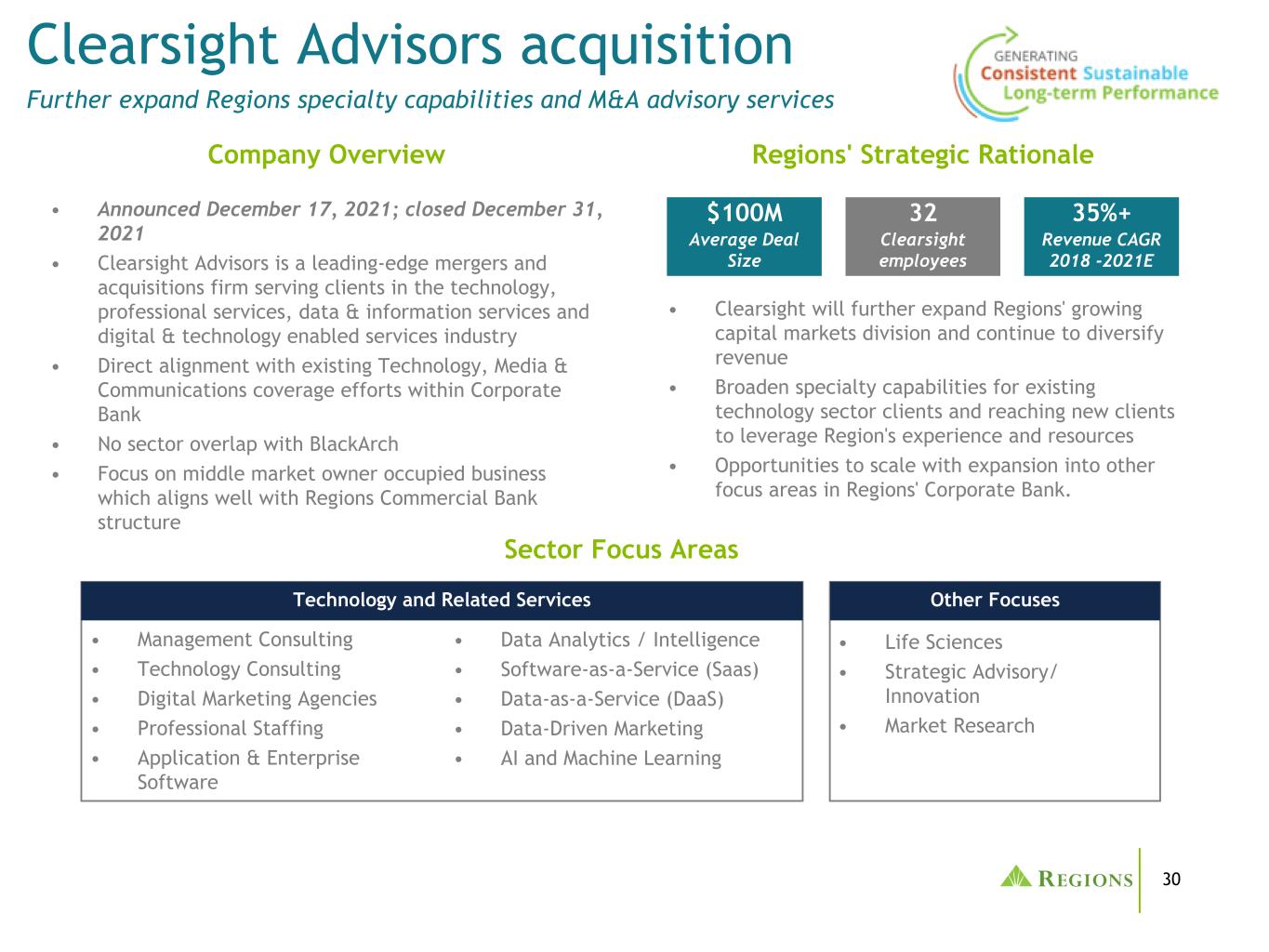
30 Clearsight Advisors acquisition Further expand Regions specialty capabilities and M&A advisory services Company Overview • Announced December 17, 2021; closed December 31, 2021 • Clearsight Advisors is a leading-edge mergers and acquisitions firm serving clients in the technology, professional services, data & information services and digital & technology enabled services industry • Direct alignment with existing Technology, Media & Communications coverage efforts within Corporate Bank • No sector overlap with BlackArch • Focus on middle market owner occupied business which aligns well with Regions Commercial Bank structure Regions' Strategic Rationale Sector Focus Areas Technology and Related Services Other Focuses • Management Consulting • Technology Consulting • Digital Marketing Agencies • Professional Staffing • Application & Enterprise Software • Data Analytics / Intelligence • Software-as-a-Service (Saas) • Data-as-a-Service (DaaS) • Data-Driven Marketing • AI and Machine Learning • Life Sciences • Strategic Advisory/ Innovation • Market Research 32 Clearsight employees 35%+ Revenue CAGR 2018 -2021E $100M Average Deal Size • Clearsight will further expand Regions' growing capital markets division and continue to diversify revenue • Broaden specialty capabilities for existing technology sector clients and reaching new clients to leverage Region's experience and resources • Opportunities to scale with expansion into other focus areas in Regions' Corporate Bank.
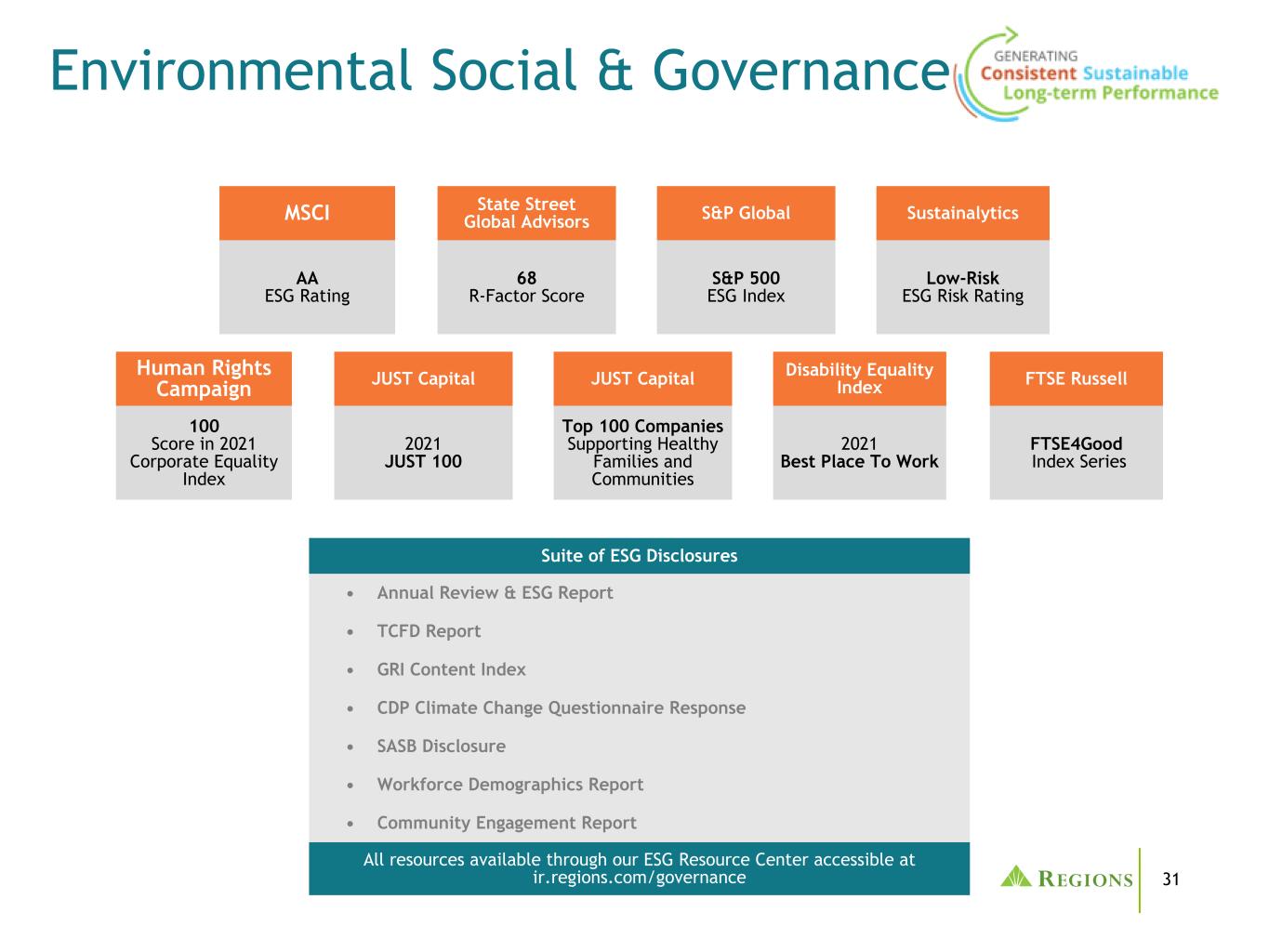
31 Environmental Social & Governance MSCI State Street Global Advisors S&P Global Sustainalytics AA ESG Rating 68 R-Factor Score S&P 500 ESG Index Low-Risk ESG Risk Rating Human Rights Campaign JUST Capital JUST Capital Disability Equality Index FTSE Russell 100 Score in 2021 Corporate Equality Index 2021 JUST 100 Top 100 Companies Supporting Healthy Families and Communities 2021 Best Place To Work FTSE4Good Index Series Suite of ESG Disclosures • Annual Review & ESG Report • TCFD Report • GRI Content Index • CDP Climate Change Questionnaire Response • SASB Disclosure • Workforce Demographics Report • Community Engagement Report All resources available through our ESG Resource Center accessible at ir.regions.com/governance

32 Management uses pre-tax pre-provision income (non-GAAP) and adjusted pre-tax pre-provision income (non-GAAP), as well as the adjusted efficiency ratio (non-GAAP) and the adjusted fee income ratio (non-GAAP) to monitor performance and believes these measures provide meaningful information to investors. Non-interest expense (GAAP) is presented excluding certain adjustments to arrive at adjusted non-interest expense (non-GAAP), which is the numerator for the efficiency ratio. Non-interest income (GAAP) is presented excluding certain adjustments to arrive at adjusted non-interest income (non-GAAP), which is the numerator for the fee income ratio. Adjusted non-interest income (non-GAAP) and adjusted non-interest expense (non- GAAP) are used to determine adjusted pre-tax pre-provision income (non-GAAP). Net interest income (GAAP) on a taxable-equivalent basis and non-interest income are added together to arrive at total revenue on a taxable-equivalent basis. Adjustments are made to arrive at adjusted total revenue on a taxable-equivalent basis (non-GAAP), which is the denominator for the fee income and efficiency ratios. Regions believes that the exclusion of these adjustments provides a meaningful base for period-to-period comparisons, which management believes will assist investors in analyzing the operating results of the Company and predicting future performance. These non-GAAP financial measures are also used by management to assess the performance of Regions’ business. It is possible that the activities related to the adjustments may recur; however, management does not consider the activities related to the adjustments to be indications of ongoing operations. Regions believes that presentation of these non-GAAP financial measures will permit investors to assess the performance of the Company on the same basis as that applied by management. The allowance for credit losses (ACL) as a percentage of total loans is an important ratio, especially during periods of economic stress. Management believes this ratio provides investors with meaningful additional information about credit loss allowance levels when the impact of SBA's Paycheck Protection Program loans, which are fully backed by the U.S. government, and any related allowance are excluded from total loans and total allowance which are the denominator and numerator, respectively, used in the ACL ratio. This adjusted ACL ratio represents a non-GAAP financial measure. Tangible common stockholders’ equity ratios have become a focus of some investors and management believes they may assist investors in analyzing the capital position of the Company absent the effects of intangible assets and preferred stock. Analysts and banking regulators have assessed Regions’ capital adequacy using the tangible common stockholders’ equity measure. Because tangible common stockholders’ equity is not formally defined by GAAP or prescribed in any amount by federal banking regulations it is currently considered to be a non- GAAP financial measure and other entities may calculate it differently than Regions’ disclosed calculations. Since analysts and banking regulators may assess Regions’ capital adequacy using tangible common stockholders’ equity, management believes that it is useful to provide investors the ability to assess Regions’ capital adequacy on this same basis. Non-GAAP financial measures have inherent limitations, are not required to be uniformly applied and are not audited. Although these non-GAAP financial measures are frequently used by stakeholders in the evaluation of a company, they have limitations as analytical tools, and should not be considered in isolation, or as a substitute for analyses of results as reported under GAAP. In particular, a measure of earnings that excludes selected items does not represent the amount that effectively accrues directly to stockholders. Management and the Board of Directors utilize non-GAAP measures as follows: • Preparation of Regions' operating budgets • Monthly financial performance reporting • Monthly close-out reporting of consolidated results (management only) • Presentation to investors of company performance • Metrics for incentive compensation Non-GAAP information
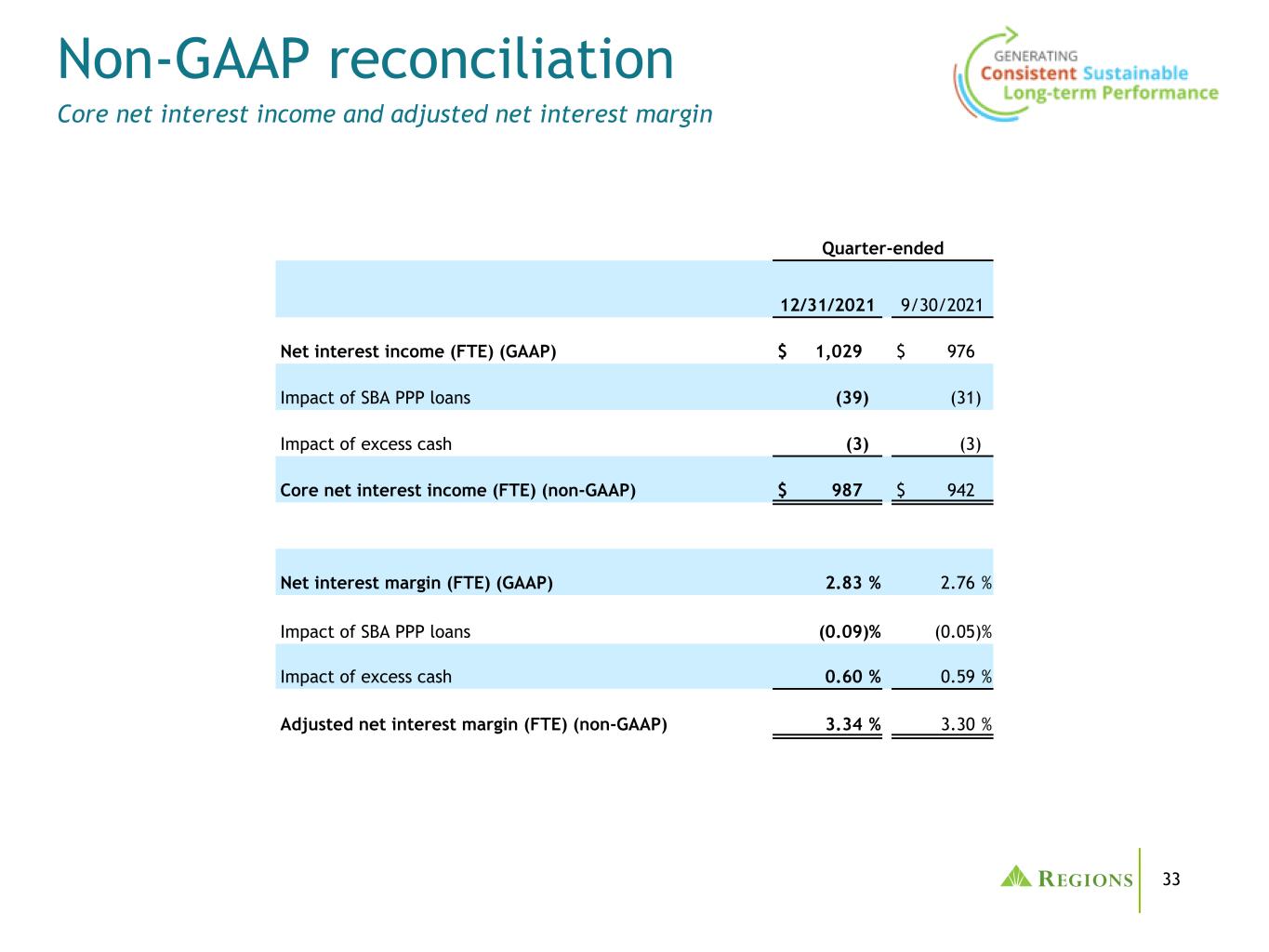
33 Non-GAAP reconciliation Core net interest income and adjusted net interest margin Quarter-ended 12/31/2021 9/30/2021 Net interest income (FTE) (GAAP) $ 1,029 $ 976 Impact of SBA PPP loans (39) (31) Impact of excess cash (3) (3) Core net interest income (FTE) (non-GAAP) $ 987 $ 942 Net interest margin (FTE) (GAAP) 2.83 % 2.76 % Impact of SBA PPP loans (0.09) % (0.05) % Impact of excess cash 0.60 % 0.59 % Adjusted net interest margin (FTE) (non-GAAP) 3.34 % 3.30 %
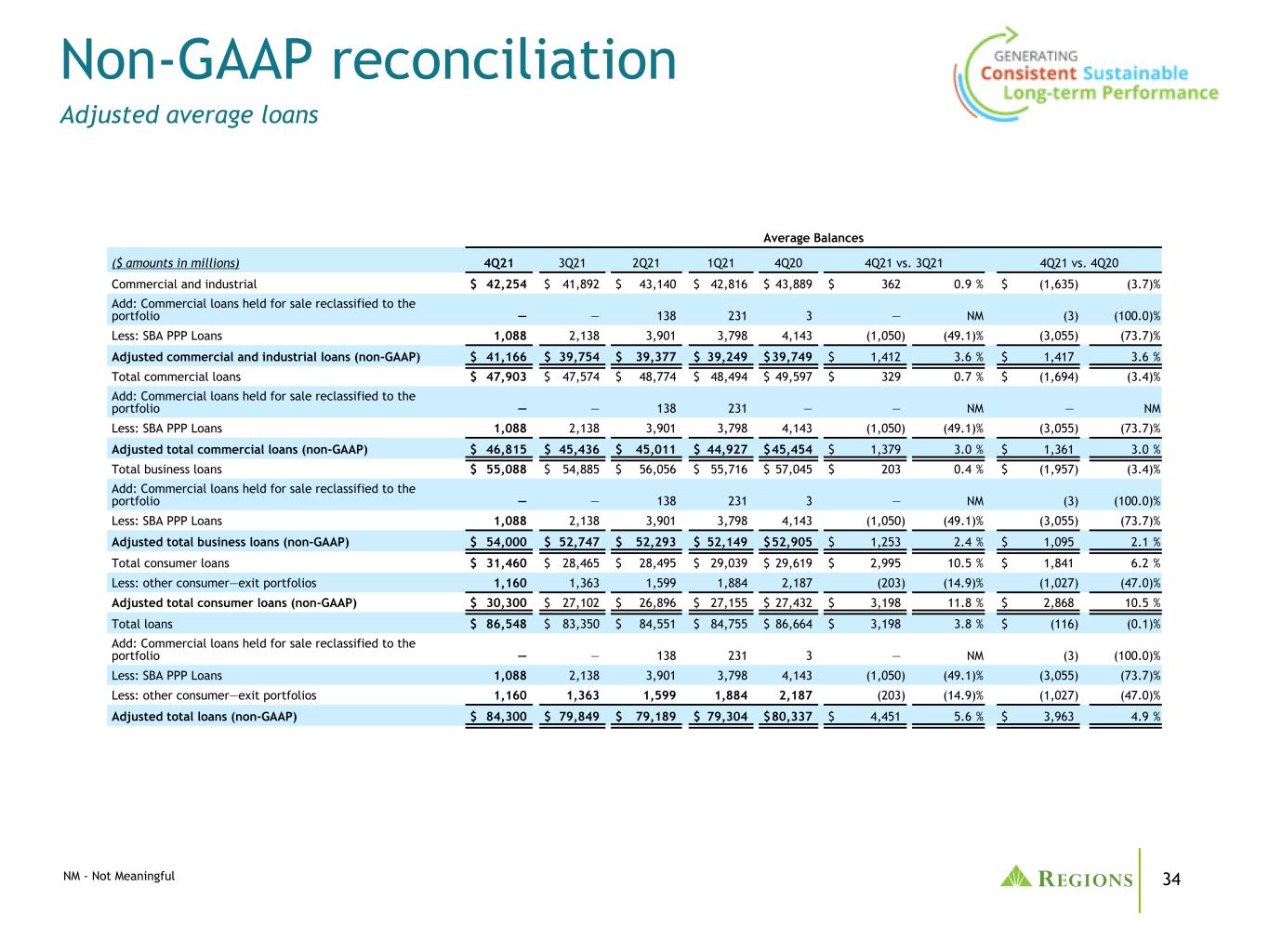
34 Non-GAAP reconciliation Adjusted average loans Average Balances ($ amounts in millions) 4Q21 3Q21 2Q21 1Q21 4Q20 4Q21 vs. 3Q21 4Q21 vs. 4Q20 Commercial and industrial $ 42,254 $ 41,892 $ 43,140 $ 42,816 $ 43,889 $ 362 0.9 % $ (1,635) (3.7) % Add: Commercial loans held for sale reclassified to the portfolio — — 138 231 3 — NM (3) (100.0) % Less: SBA PPP Loans 1,088 2,138 3,901 3,798 4,143 (1,050) (49.1) % (3,055) (73.7) % Adjusted commercial and industrial loans (non-GAAP) $ 41,166 $ 39,754 $ 39,377 $ 39,249 $ 39,749 $ 1,412 3.6 % $ 1,417 3.6 % Total commercial loans $ 47,903 $ 47,574 $ 48,774 $ 48,494 $ 49,597 $ 329 0.7 % $ (1,694) (3.4) % Add: Commercial loans held for sale reclassified to the portfolio — — 138 231 — — NM — NM Less: SBA PPP Loans 1,088 2,138 3,901 3,798 4,143 (1,050) (49.1) % (3,055) (73.7) % Adjusted total commercial loans (non-GAAP) $ 46,815 $ 45,436 $ 45,011 $ 44,927 $ 45,454 $ 1,379 3.0 % $ 1,361 3.0 % Total business loans $ 55,088 $ 54,885 $ 56,056 $ 55,716 $ 57,045 $ 203 0.4 % $ (1,957) (3.4) % Add: Commercial loans held for sale reclassified to the portfolio — — 138 231 3 — NM (3) (100.0) % Less: SBA PPP Loans 1,088 2,138 3,901 3,798 4,143 (1,050) (49.1) % (3,055) (73.7) % Adjusted total business loans (non-GAAP) $ 54,000 $ 52,747 $ 52,293 $ 52,149 $ 52,905 $ 1,253 2.4 % $ 1,095 2.1 % Total consumer loans $ 31,460 $ 28,465 $ 28,495 $ 29,039 $ 29,619 $ 2,995 10.5 % $ 1,841 6.2 % Less: other consumer—exit portfolios 1,160 1,363 1,599 1,884 2,187 (203) (14.9) % (1,027) (47.0) % Adjusted total consumer loans (non-GAAP) $ 30,300 $ 27,102 $ 26,896 $ 27,155 $ 27,432 $ 3,198 11.8 % $ 2,868 10.5 % Total loans $ 86,548 $ 83,350 $ 84,551 $ 84,755 $ 86,664 $ 3,198 3.8 % $ (116) (0.1) % Add: Commercial loans held for sale reclassified to the portfolio — — 138 231 3 — NM (3) (100.0) % Less: SBA PPP Loans 1,088 2,138 3,901 3,798 4,143 (1,050) (49.1) % (3,055) (73.7) % Less: other consumer—exit portfolios 1,160 1,363 1,599 1,884 2,187 (203) (14.9) % (1,027) (47.0) % Adjusted total loans (non-GAAP) $ 84,300 $ 79,849 $ 79,189 $ 79,304 $ 80,337 $ 4,451 5.6 % $ 3,963 4.9 % NM - Not Meaningful

35 Non-GAAP reconciliation Adjusted full year average loans Average Balance Average Balance Average Balance Twelve Months Ended Twelve Months Ended Twelve Months Ended ($ amounts in millions) December 31, 2021 December 31, 2020 2021 vs. 2020 Total Loans $ 84,802 $ 87,813 $ (3,011) (3.4) % Add: Commercial loans held for sale reclassified to the portfolio 91 1 90 NM Less: SBA PPP Loans 2,722 2,986 (264) (8.8) % Less: other consumer—exit portfolios 1,499 2,758 (1,259) (45.6) % Adjusted total loans (non-GAAP) 80,672 82,070 (1,398) (1.7) % NM - Not Meaningful

36 Non-GAAP reconciliation Adjusted ending loans As of 12/31/2021 12/31/2021 ($ amounts in millions) 12/31/2021 9/30/2021 6/30/2021 3/31/2021 12/31/2020 vs. 9/30/2021 vs. 12/31/2020 Commercial and industrial $ 43,758 $ 41,748 $ 42,628 $ 43,241 $ 42,870 $ 2,010 4.8 % $ 888 2.1 % Add: Commercial loans held for sale reclassified to the portfolio — — — 210 239 — NM (239) (100.0) % Less: SBA PPP Loans 748 1,536 2,948 4,317 3,624 (788) (51.3) % (2,876) (79.4) % Adjusted commercial and industrial loans (non-GAAP) $ 43,010 $ 40,212 $ 39,680 $ 39,134 $ 39,485 $ 2,798 7.0 % $ 3,525 8.9 % Total commercial loans $ 49,309 $ 47,446 $ 48,254 $ 48,869 $ 48,575 $ 1,863 3.9 % $ 734 1.5 % Add: Commercial loans held for sale reclassified to the portfolio — — — 210 239 — NM (239) (100.0) % Less: SBA PPP Loans 748 1,536 2,948 4,317 3,624 (788) (51.3) % (2,876) (79.4) % Adjusted total commercial loans (non-GAAP) $ 48,561 $ 45,910 $ 45,306 $ 44,762 $ 45,190 $ 2,651 5.8 % $ 3,371 7.5 % Total business loans $ 56,336 $ 54,758 $ 55,502 $ 56,091 $ 55,838 $ 1,578 2.9 % $ 498 0.9 % Add: Commercial loans held for sale reclassified to the portfolio — — — 210 239 — NM (239) (100.0) % Less: SBA PPP Loans 748 1,536 2,948 4,317 3,624 (788) (51.3) % (2,876) (79.4) % Adjusted total business loans (non-GAAP) $ 55,588 $ 53,222 $ 52,554 $ 51,984 $ 52,453 $ 2,366 4.4 % $ 3,135 6.0 % Total consumer loans $ 31,448 $ 28,512 $ 28,572 $ 28,664 $ 29,428 $ 2,936 10.3 % $ 2,020 6.9 % Less: Other consumer- exit portfolios 1,071 1,260 1,479 1,739 2,035 (189) (15.0) % (964) (47.4) % Adjusted total consumer loans (non-GAAP) $ 30,377 $ 27,252 $ 27,093 $ 26,925 $ 27,393 $ 3,125 11.5 % $ 2,984 10.9 % Total loans $ 87,784 $ 83,270 $ 84,074 $ 84,755 $ 85,266 $ 4,514 5.4 % $ 2,518 3.0 % Add: Commercial loans held for sale reclassified to the portfolio — — — 210 239 — NM (239) (100.0) % Less: SBA PPP Loans 748 1,536 2,948 4,317 3,624 (788) (51.3) % (2,876) (79.4) % Less: Other consumer- exit portfolios 1,071 1,260 1,479 1,739 2,035 (189) (15.0) % (964) (47.4) % Adjusted ending total loans (non-GAAP) $ 85,965 $ 80,474 $ 79,647 $ 78,909 $ 79,846 $ 5,491 6.8 % $ 6,119 7.7 % NM - Not Meaningful
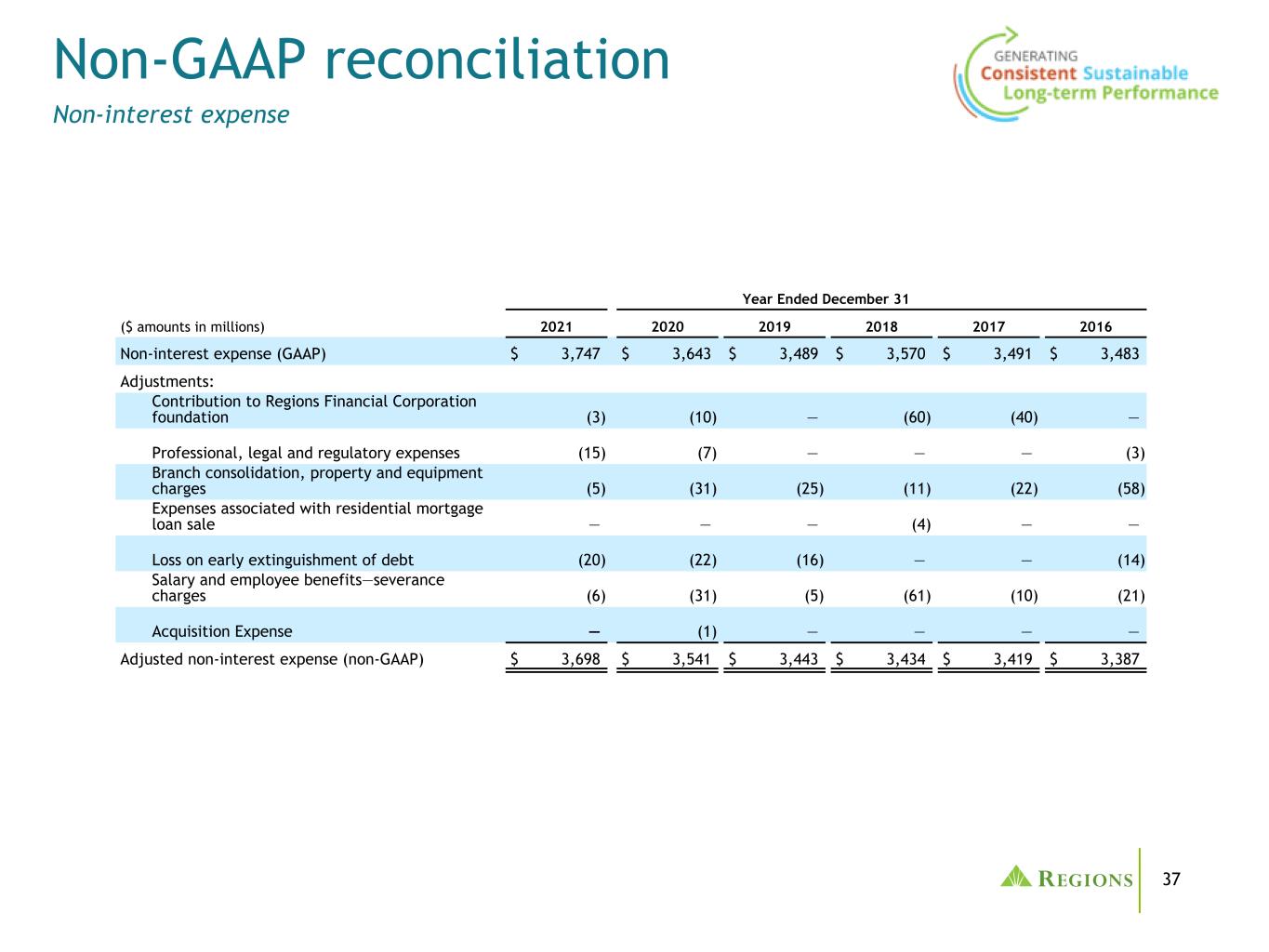
37 Non-GAAP reconciliation Non-interest expense Year Ended December 31 ($ amounts in millions) 2021 2020 2019 2018 2017 2016 Non-interest expense (GAAP) $ 3,747 $ 3,643 $ 3,489 $ 3,570 $ 3,491 $ 3,483 Adjustments: Contribution to Regions Financial Corporation foundation (3) (10) — (60) (40) — Professional, legal and regulatory expenses (15) (7) — — — (3) Branch consolidation, property and equipment charges (5) (31) (25) (11) (22) (58) Expenses associated with residential mortgage loan sale — — — (4) — — Loss on early extinguishment of debt (20) (22) (16) — — (14) Salary and employee benefits—severance charges (6) (31) (5) (61) (10) (21) Acquisition Expense — (1) — — — — Adjusted non-interest expense (non-GAAP) $ 3,698 $ 3,541 $ 3,443 $ 3,434 $ 3,419 $ 3,387

38 Non-GAAP reconciliation ACL/Loans excluding PPP As of ($ amounts in millions) 12/31/2021 9/30/2021 6/30/2021 3/31/2021 12/31/2020 Total Loans $ 87,784 $ 83,270 $ 84,074 $ 84,755 $ 85,266 Less: SBA PPP Loans 748 1,536 2,948 4,317 3,624 Loans excluding PPP, net (non- GAAP) $ 87,036 $ 81,734 $ 81,126 $ 80,438 $ 81,642 ACL at period end $ 1,574 $ 1,499 $ 1,684 $ 2,068 $ 2,293 Less: SBA PPP Loans' ACL $ 2 $ 2 $ 3 $ 3 $ 1 ACL excluding PPP Loans' ACL (non-GAAP) $ 1,572 $ 1,497 $ 1,681 $ 2,065 $ 2,292 ACL/Loans excluding PPP, net (non-GAAP) 1.81 % 1.83 % 2.07 % 2.57 % 2.81 %
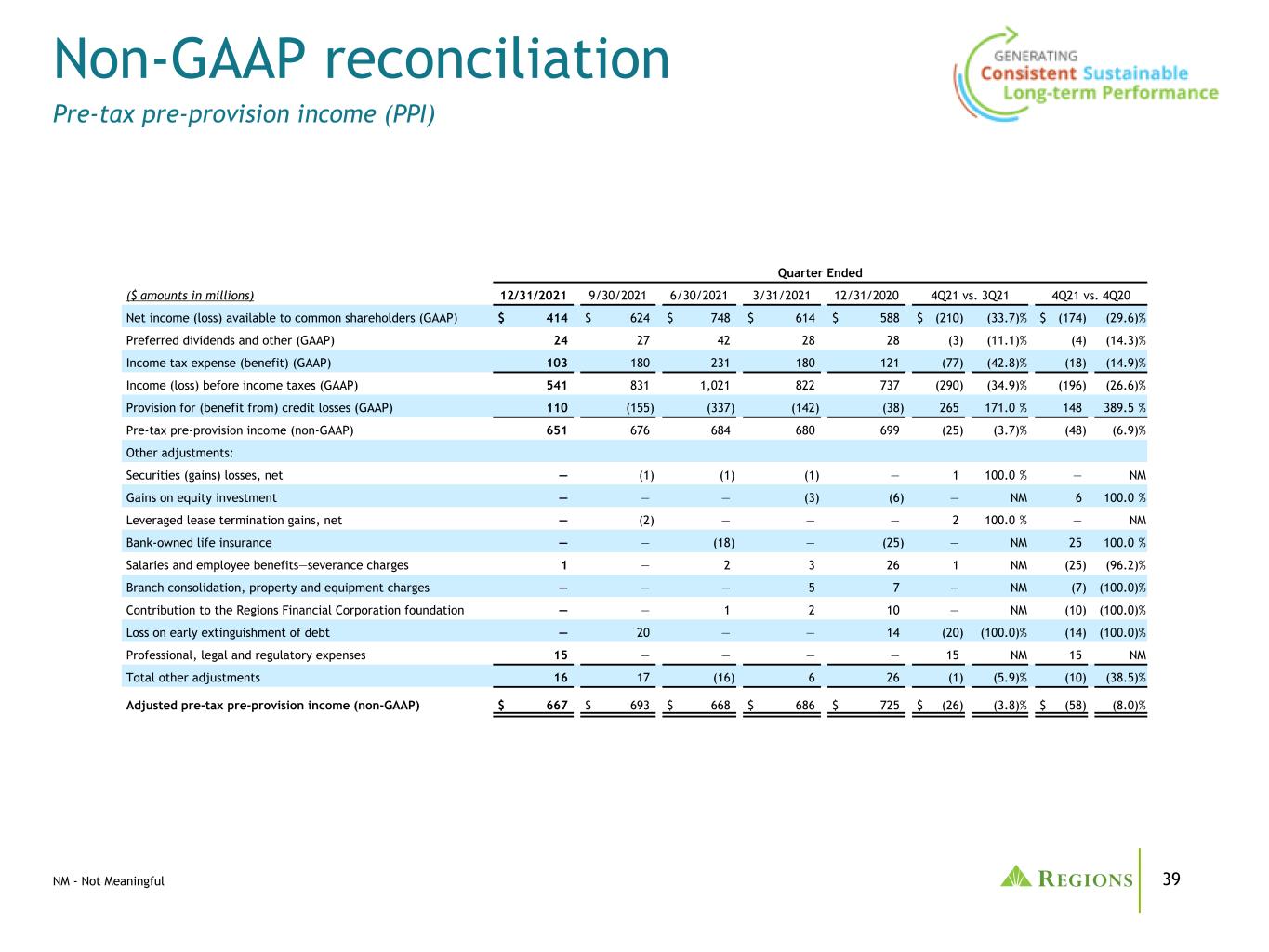
39 Non-GAAP reconciliation Pre-tax pre-provision income (PPI) Quarter Ended ($ amounts in millions) 12/31/2021 9/30/2021 6/30/2021 3/31/2021 12/31/2020 4Q21 vs. 3Q21 4Q21 vs. 4Q20 Net income (loss) available to common shareholders (GAAP) $ 414 $ 624 $ 748 $ 614 $ 588 $ (210) (33.7) % $ (174) (29.6) % Preferred dividends and other (GAAP) 24 27 42 28 28 (3) (11.1) % (4) (14.3) % Income tax expense (benefit) (GAAP) 103 180 231 180 121 (77) (42.8) % (18) (14.9) % Income (loss) before income taxes (GAAP) 541 831 1,021 822 737 (290) (34.9) % (196) (26.6) % Provision for (benefit from) credit losses (GAAP) 110 (155) (337) (142) (38) 265 171.0 % 148 389.5 % Pre-tax pre-provision income (non-GAAP) 651 676 684 680 699 (25) (3.7) % (48) (6.9) % Other adjustments: Securities (gains) losses, net — (1) (1) (1) — 1 100.0 % — NM Gains on equity investment — — — (3) (6) — NM 6 100.0 % Leveraged lease termination gains, net — (2) — — — 2 100.0 % — NM Bank-owned life insurance — — (18) — (25) — NM 25 100.0 % Salaries and employee benefits—severance charges 1 — 2 3 26 1 NM (25) (96.2) % Branch consolidation, property and equipment charges — — — 5 7 — NM (7) (100.0) % Contribution to the Regions Financial Corporation foundation — — 1 2 10 — NM (10) (100.0) % Loss on early extinguishment of debt — 20 — — 14 (20) (100.0) % (14) (100.0) % Professional, legal and regulatory expenses 15 — — — — 15 NM 15 NM Total other adjustments 16 17 (16) 6 26 (1) (5.9) % (10) (38.5) % Adjusted pre-tax pre-provision income (non-GAAP) $ 667 $ 693 $ 668 $ 686 $ 725 $ (26) (3.8) % $ (58) (8.0) % NM - Not Meaningful

40 Non-GAAP reconciliation Pre-tax pre-provision income (PPI) NM - Not Meaningful Year Ended ($ amounts in millions) 12/31/2021 12/31/2020 2021 vs. 2020 Net income available to common shareholders (GAAP) $ 2,400 $ 991 $ 1,409 142.2 % Preferred dividends (GAAP) 121 103 18 17.5 % Income tax expense (GAAP) 694 220 474 215.5 % Income before income taxes (GAAP) 3,215 1,314 1,901 144.7 % Provision for credit losses (GAAP) (524) 1,330 (1,854) (139.4) % Pre-tax pre-provision income (non-GAAP) 2,691 2,644 47 1.8 % Other adjustments: Securities (gains) losses, net (3) (4) 1 25.0 % Gains on equity investment (3) (50) 47 94.0 Leveraged lease termination gains, net (2) (2) — — % Bank owned life insurance (18) (25) 7 28.0 % Salaries and employee benefits—severance charges 6 31 (25) (80.6) % Branch consolidation, property and equipment charges 5 31 (26) (83.9) % Contribution to the Regions Financial Corporation foundation 3 10 (7) (70.0) % Loss on early extinguishment of debt 20 22 (2) (9.1) Professional, legal and regulatory expenses 15 7 8 114.3 Ascentium expenses — 1 (1) (100.0) Total other adjustments 23 21 2 9.5 % Adjusted pre-tax pre-provision income (non-GAAP) $ 2,714 $ 2,665 $ 49 1.8 %

41 Non-GAAP reconciliation NII, non-interest income/expense, and efficiency ratio NM - Not Meaningful Quarter Ended ($ amounts in millions) 12/31/2021 9/30/2021 6/30/2021 3/31/2021 12/31/2020 4Q21 vs. 3Q21 4Q21 vs. 4Q20 Non-interest expense (GAAP) A $ 983 $ 938 $ 898 $ 928 $ 987 $ 45 4.8 % $ (4) (0.4) % Adjustments: Contribution to the Regions Financial Corporation foundation — — (1) (2) (10) — NM 10 100.0 Branch consolidation, property and equipment charges — — — (5) (7) — NM 7 100.0 % Salary and employee benefits—severance charges (1) — (2) (3) (26) (1) NM 25 96.2 % Loss on early extinguishment of debt — (20) — — (14) 20 100.0 % 14 NM Professional, legal and regulatory expenses (15) — — — — (15) NM (15) NM Adjusted non-interest expense (non-GAAP) B $ 967 $ 918 $ 895 $ 918 $ 930 $ 49 5.3 % $ 37 4.0 % Net interest income (GAAP) C $ 1,019 $ 965 $ 963 $ 967 $ 1,006 $ 54 5.6 % 13 1.3 % Taxable-equivalent adjustment 10 11 12 11 11 (1) (9.1) % (1) (9.1) % Net interest income, taxable-equivalent basis D $ 1,029 $ 976 $ 975 $ 978 $ 1,017 $ 53 5.4 % $ 12 1.2 % Non-interest income (GAAP) E 615 649 619 641 680 (34) (5.2) % (65) (9.6) % Adjustments: Securities (gains) losses, net — (1) (1) (1) — 1 100.0 % — NM Gains on equity investment — — — (3) (6) — NM 6 100.0 % Leveraged lease termination gains — (2) — — — 2 100.0 % — NM Bank-owned life insurance — — (18) — (25) — NM 25 100.0 % Adjusted non-interest income (non-GAAP) F $ 615 $ 646 $ 600 $ 637 $ 649 (31) (4.80) % -34 (5.2) % Total revenue C+E=G $ 1,634 $ 1,614 $ 1,582 $ 1,608 $ 1,686 $ 20 1.2 % $ (52) (3.1) % Adjusted total revenue (non-GAAP) C+F=H $ 1,634 $ 1,611 $ 1,563 $ 1,604 $ 1,655 $ 23 1.4 % $ (21) (1.3) % Total revenue, taxable-equivalent basis D+E=I $ 1,644 $ 1,625 $ 1,594 $ 1,619 $ 1,697 $ 19 1.2 % $ (53) (3.1) % Adjusted total revenue, taxable-equivalent basis (non-GAAP) D+F=J $ 1,644 $ 1,622 $ 1,575 $ 1,615 $ 1,666 $ 22 1.4 % $ (22) (1.3) % Efficiency ratio (GAAP) A/I 59.8 % 57.7 % 56.4 % 57.3 % 58.1 % Adjusted efficiency ratio (non-GAAP) B/J 58.8 % 56.6 % 56.9 % 56.8 % 55.8 % Fee income ratio (GAAP) E/I 37.4 % 40.0 % 38.8 % 39.6 % 40.1 % Adjusted fee income ratio (non-GAAP) F/J 37.4 % 39.8 % 38.1 % 39.4 % 38.9 %
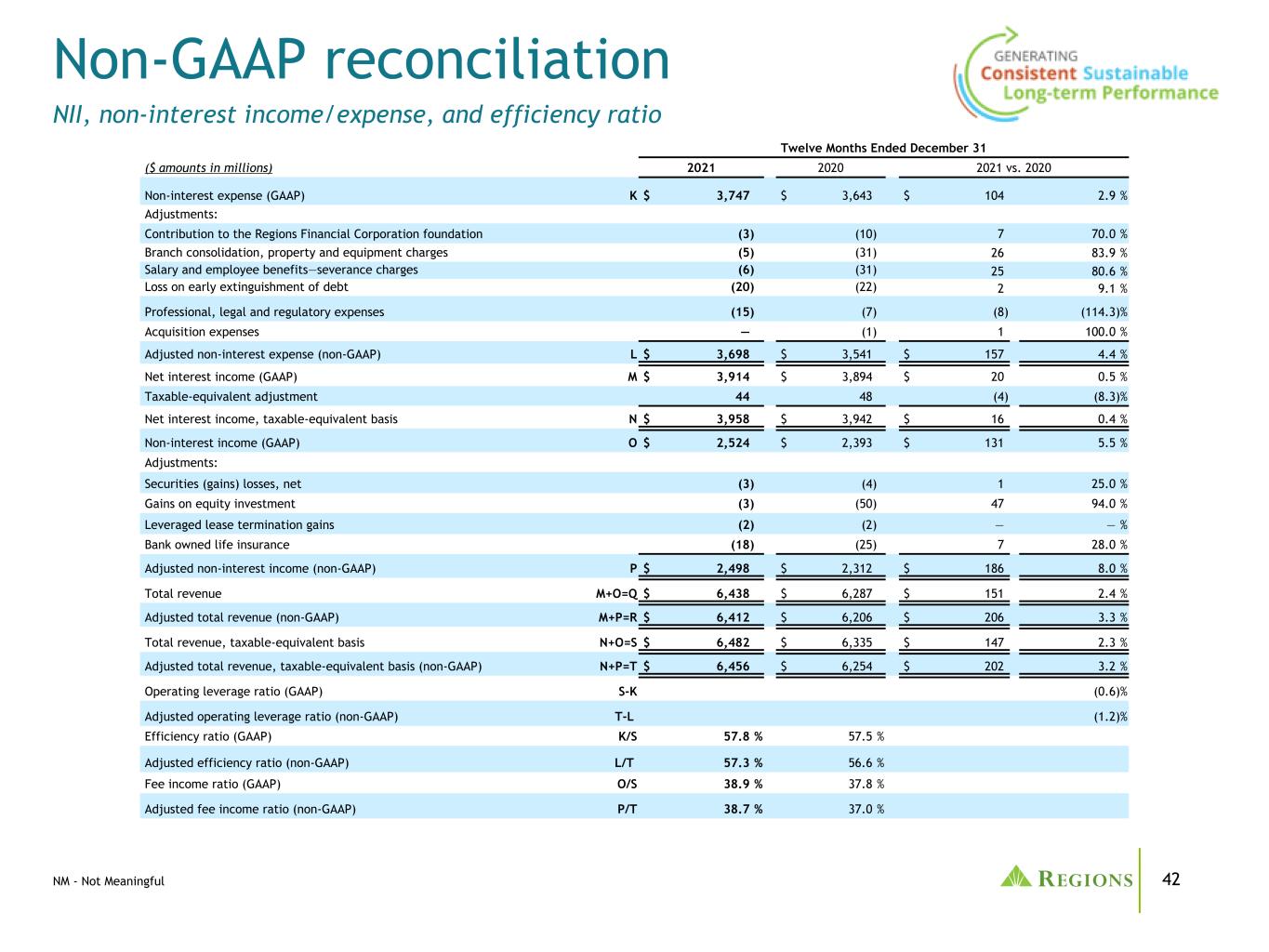
42 Non-GAAP reconciliation NII, non-interest income/expense, and efficiency ratio NM - Not Meaningful Twelve Months Ended December 31 ($ amounts in millions) 2021 2020 2021 vs. 2020 Non-interest expense (GAAP) K $ 3,747 $ 3,643 $ 104 2.9 % Adjustments: Contribution to the Regions Financial Corporation foundation (3) (10) 7 70.0 % Branch consolidation, property and equipment charges (5) (31) 26 83.9 % Salary and employee benefits—severance charges (6) (31) 25 80.6 % Loss on early extinguishment of debt (20) (22) 2 9.1 % Professional, legal and regulatory expenses (15) (7) (8) (114.3) % Acquisition expenses — (1) 1 100.0 % Adjusted non-interest expense (non-GAAP) L $ 3,698 $ 3,541 $ 157 4.4 % Net interest income (GAAP) M $ 3,914 $ 3,894 $ 20 0.5 % Taxable-equivalent adjustment 44 48 (4) (8.3) % Net interest income, taxable-equivalent basis N $ 3,958 $ 3,942 $ 16 0.4 % Non-interest income (GAAP) O $ 2,524 $ 2,393 $ 131 5.5 % Adjustments: Securities (gains) losses, net (3) (4) 1 25.0 % Gains on equity investment (3) (50) 47 94.0 % Leveraged lease termination gains (2) (2) — — % Bank owned life insurance (18) (25) 7 28.0 % Adjusted non-interest income (non-GAAP) P $ 2,498 $ 2,312 $ 186 8.0 % Total revenue M+O=Q $ 6,438 $ 6,287 $ 151 2.4 % Adjusted total revenue (non-GAAP) M+P=R $ 6,412 $ 6,206 $ 206 3.3 % Total revenue, taxable-equivalent basis N+O=S $ 6,482 $ 6,335 $ 147 2.3 % Adjusted total revenue, taxable-equivalent basis (non-GAAP) N+P=T $ 6,456 $ 6,254 $ 202 3.2 % Operating leverage ratio (GAAP) S-K (0.6) % Adjusted operating leverage ratio (non-GAAP) T-L (1.2) % Efficiency ratio (GAAP) K/S 57.8 % 57.5 % Adjusted efficiency ratio (non-GAAP) L/T 57.3 % 56.6 % Fee income ratio (GAAP) O/S 38.9 % 37.8 % Adjusted fee income ratio (non-GAAP) P/T 38.7 % 37.0 %

43 Non-GAAP reconciliation Non-interest income Year Ended ($ amounts in millions) 2011 2012 2013 2014 2015 2016 2017 2018 2019 2020 2021 Non-interest income (GAAP) $ 2,226 $ 2,201 $ 2,096 $ 1,785 $ 1,937 $ 2,011 $ 1,962 $ 2,019 $ 2,116 $ 2,393 $ 2,524 Security (gains) losses, net (112) (48) (26) (27) (29) (6) (19) (1) 28 (4) (3) Bank Owned Life Insurance - Adusted Items — — — — — — — — — (25) (18) Leverage Lease Terminations Inc (8) (14) (39) (10) (8) (8) (1) (8) (1) (2) (2) Loss on sale of mortgage loans 3 — — — — — — — — — — Gain on sale of other assets — — (24) — — — — — — — — Gain on sale of affordable housing residential mortgage loans — — — — — (5) (5) — (8) — — Gains on equity investment — — — — — — — — — (50) (3) Insurance proceeds — — — — (91) (50) — — — — — Adjusted non-interest income (non- GAAP) $ 2,109 $ 2,139 $ 2,007 $ 1,748 $ 1,809 $ 1,942 $ 1,937 $ 2,010 $ 2,135 $ 2,312 $ 2,498
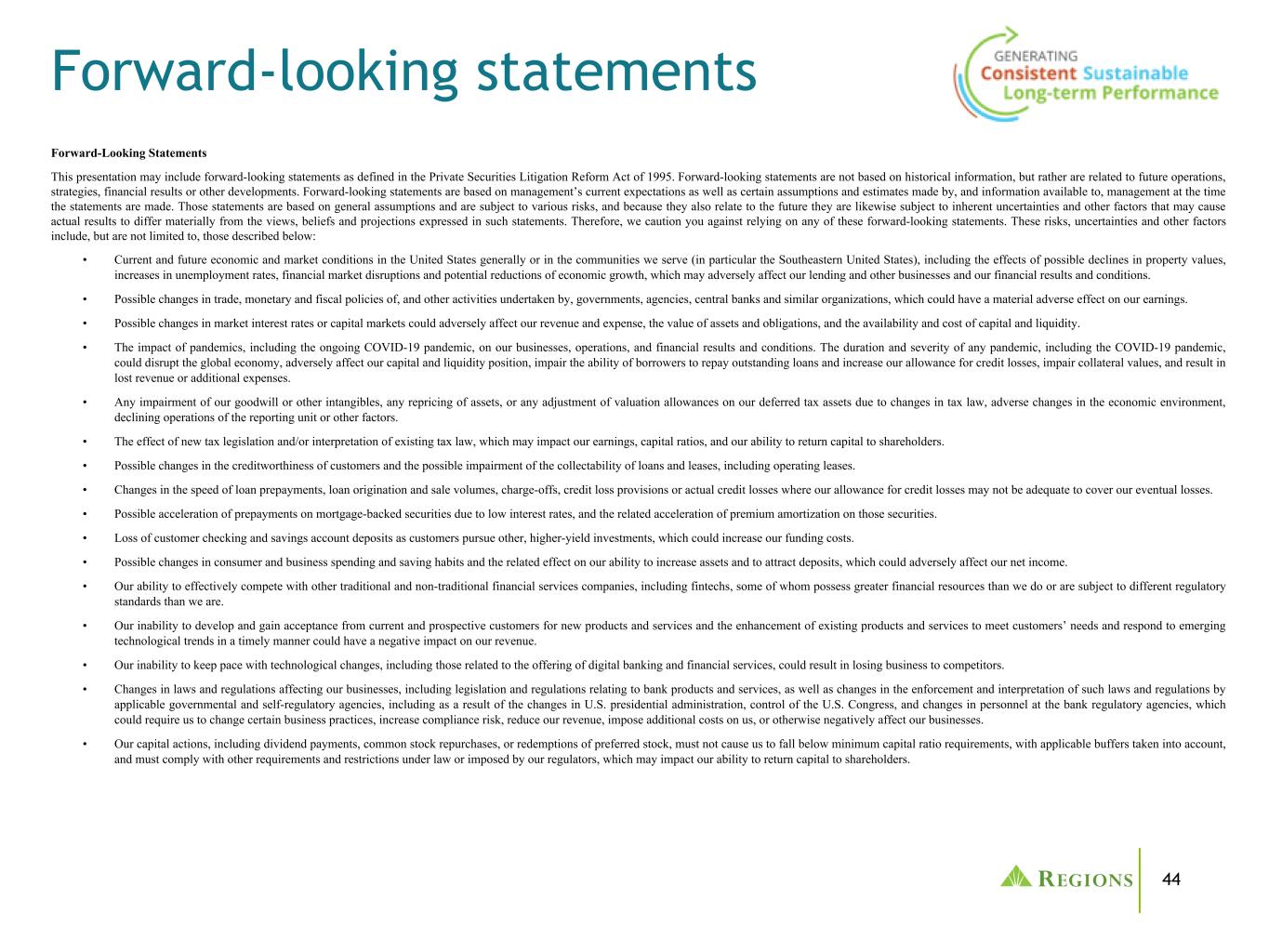
44 Forward-Looking Statements This presentation may include forward-looking statements as defined in the Private Securities Litigation Reform Act of 1995. Forward-looking statements are not based on historical information, but rather are related to future operations, strategies, financial results or other developments. Forward-looking statements are based on management’s current expectations as well as certain assumptions and estimates made by, and information available to, management at the time the statements are made. Those statements are based on general assumptions and are subject to various risks, and because they also relate to the future they are likewise subject to inherent uncertainties and other factors that may cause actual results to differ materially from the views, beliefs and projections expressed in such statements. Therefore, we caution you against relying on any of these forward-looking statements. These risks, uncertainties and other factors include, but are not limited to, those described below: • Current and future economic and market conditions in the United States generally or in the communities we serve (in particular the Southeastern United States), including the effects of possible declines in property values, increases in unemployment rates, financial market disruptions and potential reductions of economic growth, which may adversely affect our lending and other businesses and our financial results and conditions. • Possible changes in trade, monetary and fiscal policies of, and other activities undertaken by, governments, agencies, central banks and similar organizations, which could have a material adverse effect on our earnings. • Possible changes in market interest rates or capital markets could adversely affect our revenue and expense, the value of assets and obligations, and the availability and cost of capital and liquidity. • The impact of pandemics, including the ongoing COVID-19 pandemic, on our businesses, operations, and financial results and conditions. The duration and severity of any pandemic, including the COVID-19 pandemic, could disrupt the global economy, adversely affect our capital and liquidity position, impair the ability of borrowers to repay outstanding loans and increase our allowance for credit losses, impair collateral values, and result in lost revenue or additional expenses. • Any impairment of our goodwill or other intangibles, any repricing of assets, or any adjustment of valuation allowances on our deferred tax assets due to changes in tax law, adverse changes in the economic environment, declining operations of the reporting unit or other factors. • The effect of new tax legislation and/or interpretation of existing tax law, which may impact our earnings, capital ratios, and our ability to return capital to shareholders. • Possible changes in the creditworthiness of customers and the possible impairment of the collectability of loans and leases, including operating leases. • Changes in the speed of loan prepayments, loan origination and sale volumes, charge-offs, credit loss provisions or actual credit losses where our allowance for credit losses may not be adequate to cover our eventual losses. • Possible acceleration of prepayments on mortgage-backed securities due to low interest rates, and the related acceleration of premium amortization on those securities. • Loss of customer checking and savings account deposits as customers pursue other, higher-yield investments, which could increase our funding costs. • Possible changes in consumer and business spending and saving habits and the related effect on our ability to increase assets and to attract deposits, which could adversely affect our net income. • Our ability to effectively compete with other traditional and non-traditional financial services companies, including fintechs, some of whom possess greater financial resources than we do or are subject to different regulatory standards than we are. • Our inability to develop and gain acceptance from current and prospective customers for new products and services and the enhancement of existing products and services to meet customers’ needs and respond to emerging technological trends in a timely manner could have a negative impact on our revenue. • Our inability to keep pace with technological changes, including those related to the offering of digital banking and financial services, could result in losing business to competitors. • Changes in laws and regulations affecting our businesses, including legislation and regulations relating to bank products and services, as well as changes in the enforcement and interpretation of such laws and regulations by applicable governmental and self-regulatory agencies, including as a result of the changes in U.S. presidential administration, control of the U.S. Congress, and changes in personnel at the bank regulatory agencies, which could require us to change certain business practices, increase compliance risk, reduce our revenue, impose additional costs on us, or otherwise negatively affect our businesses. • Our capital actions, including dividend payments, common stock repurchases, or redemptions of preferred stock, must not cause us to fall below minimum capital ratio requirements, with applicable buffers taken into account, and must comply with other requirements and restrictions under law or imposed by our regulators, which may impact our ability to return capital to shareholders. Forward-looking statements
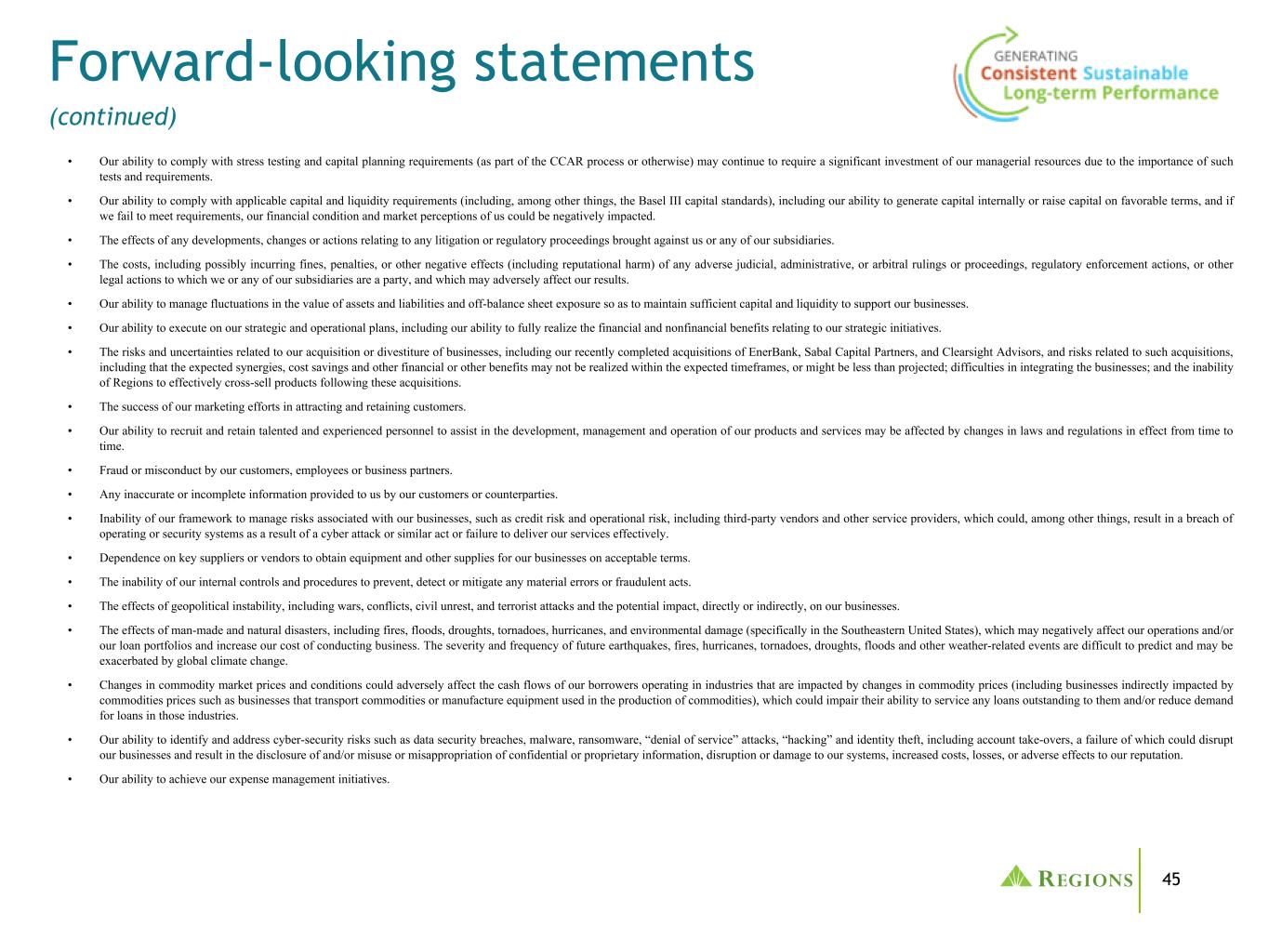
45 • Our ability to comply with stress testing and capital planning requirements (as part of the CCAR process or otherwise) may continue to require a significant investment of our managerial resources due to the importance of such tests and requirements. • Our ability to comply with applicable capital and liquidity requirements (including, among other things, the Basel III capital standards), including our ability to generate capital internally or raise capital on favorable terms, and if we fail to meet requirements, our financial condition and market perceptions of us could be negatively impacted. • The effects of any developments, changes or actions relating to any litigation or regulatory proceedings brought against us or any of our subsidiaries. • The costs, including possibly incurring fines, penalties, or other negative effects (including reputational harm) of any adverse judicial, administrative, or arbitral rulings or proceedings, regulatory enforcement actions, or other legal actions to which we or any of our subsidiaries are a party, and which may adversely affect our results. • Our ability to manage fluctuations in the value of assets and liabilities and off-balance sheet exposure so as to maintain sufficient capital and liquidity to support our businesses. • Our ability to execute on our strategic and operational plans, including our ability to fully realize the financial and nonfinancial benefits relating to our strategic initiatives. • The risks and uncertainties related to our acquisition or divestiture of businesses, including our recently completed acquisitions of EnerBank, Sabal Capital Partners, and Clearsight Advisors, and risks related to such acquisitions, including that the expected synergies, cost savings and other financial or other benefits may not be realized within the expected timeframes, or might be less than projected; difficulties in integrating the businesses; and the inability of Regions to effectively cross-sell products following these acquisitions. • The success of our marketing efforts in attracting and retaining customers. • Our ability to recruit and retain talented and experienced personnel to assist in the development, management and operation of our products and services may be affected by changes in laws and regulations in effect from time to time. • Fraud or misconduct by our customers, employees or business partners. • Any inaccurate or incomplete information provided to us by our customers or counterparties. • Inability of our framework to manage risks associated with our businesses, such as credit risk and operational risk, including third-party vendors and other service providers, which could, among other things, result in a breach of operating or security systems as a result of a cyber attack or similar act or failure to deliver our services effectively. • Dependence on key suppliers or vendors to obtain equipment and other supplies for our businesses on acceptable terms. • The inability of our internal controls and procedures to prevent, detect or mitigate any material errors or fraudulent acts. • The effects of geopolitical instability, including wars, conflicts, civil unrest, and terrorist attacks and the potential impact, directly or indirectly, on our businesses. • The effects of man-made and natural disasters, including fires, floods, droughts, tornadoes, hurricanes, and environmental damage (specifically in the Southeastern United States), which may negatively affect our operations and/or our loan portfolios and increase our cost of conducting business. The severity and frequency of future earthquakes, fires, hurricanes, tornadoes, droughts, floods and other weather-related events are difficult to predict and may be exacerbated by global climate change. • Changes in commodity market prices and conditions could adversely affect the cash flows of our borrowers operating in industries that are impacted by changes in commodity prices (including businesses indirectly impacted by commodities prices such as businesses that transport commodities or manufacture equipment used in the production of commodities), which could impair their ability to service any loans outstanding to them and/or reduce demand for loans in those industries. • Our ability to identify and address cyber-security risks such as data security breaches, malware, ransomware, “denial of service” attacks, “hacking” and identity theft, including account take-overs, a failure of which could disrupt our businesses and result in the disclosure of and/or misuse or misappropriation of confidential or proprietary information, disruption or damage to our systems, increased costs, losses, or adverse effects to our reputation. • Our ability to achieve our expense management initiatives. Forward-looking statements (continued)
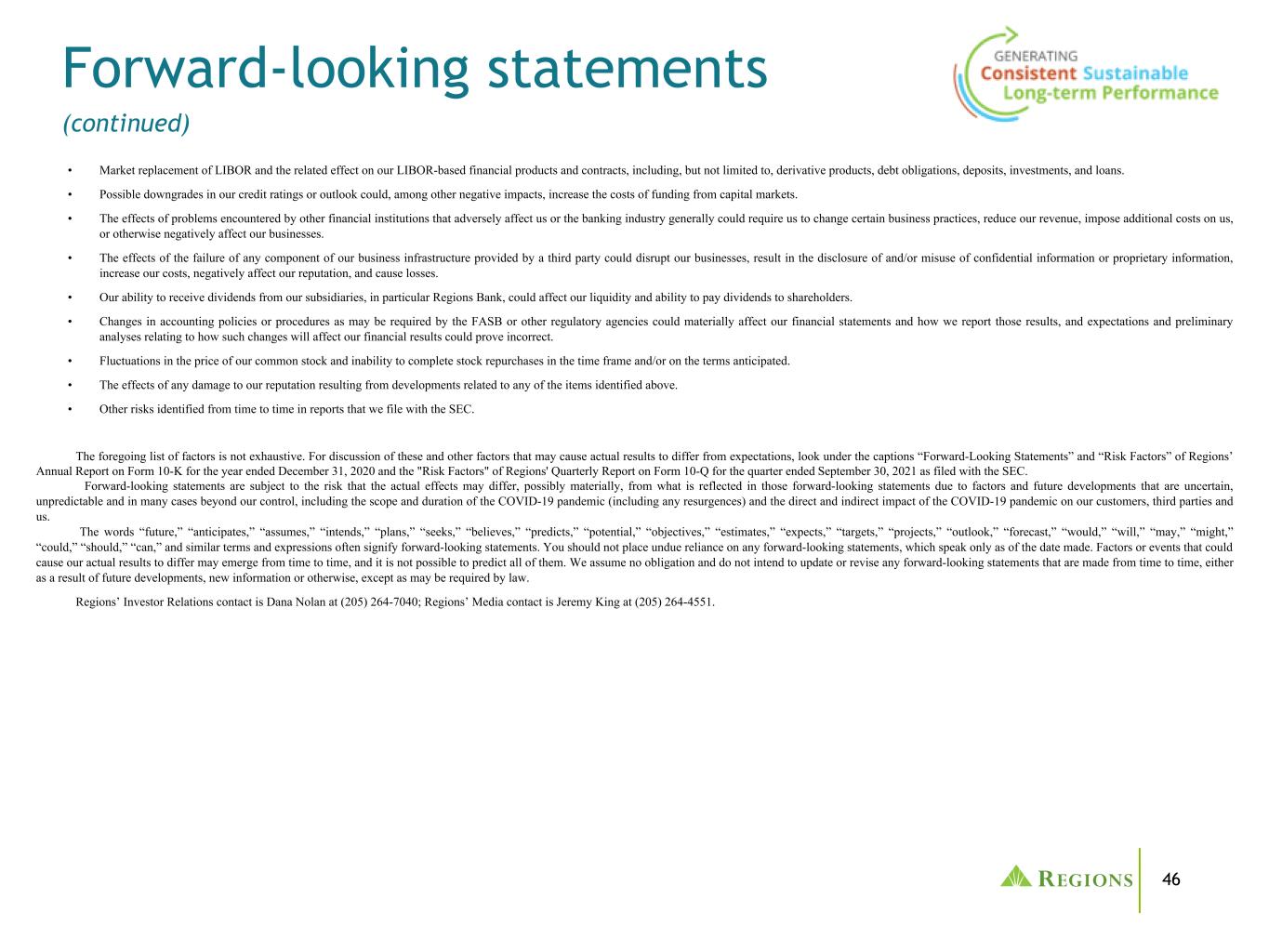
46 • Market replacement of LIBOR and the related effect on our LIBOR-based financial products and contracts, including, but not limited to, derivative products, debt obligations, deposits, investments, and loans. • Possible downgrades in our credit ratings or outlook could, among other negative impacts, increase the costs of funding from capital markets. • The effects of problems encountered by other financial institutions that adversely affect us or the banking industry generally could require us to change certain business practices, reduce our revenue, impose additional costs on us, or otherwise negatively affect our businesses. • The effects of the failure of any component of our business infrastructure provided by a third party could disrupt our businesses, result in the disclosure of and/or misuse of confidential information or proprietary information, increase our costs, negatively affect our reputation, and cause losses. • Our ability to receive dividends from our subsidiaries, in particular Regions Bank, could affect our liquidity and ability to pay dividends to shareholders. • Changes in accounting policies or procedures as may be required by the FASB or other regulatory agencies could materially affect our financial statements and how we report those results, and expectations and preliminary analyses relating to how such changes will affect our financial results could prove incorrect. • Fluctuations in the price of our common stock and inability to complete stock repurchases in the time frame and/or on the terms anticipated. • The effects of any damage to our reputation resulting from developments related to any of the items identified above. • Other risks identified from time to time in reports that we file with the SEC. The foregoing list of factors is not exhaustive. For discussion of these and other factors that may cause actual results to differ from expectations, look under the captions “Forward-Looking Statements” and “Risk Factors” of Regions’ Annual Report on Form 10-K for the year ended December 31, 2020 and the "Risk Factors" of Regions' Quarterly Report on Form 10-Q for the quarter ended September 30, 2021 as filed with the SEC. Forward-looking statements are subject to the risk that the actual effects may differ, possibly materially, from what is reflected in those forward-looking statements due to factors and future developments that are uncertain, unpredictable and in many cases beyond our control, including the scope and duration of the COVID-19 pandemic (including any resurgences) and the direct and indirect impact of the COVID-19 pandemic on our customers, third parties and us. The words “future,” “anticipates,” “assumes,” “intends,” “plans,” “seeks,” “believes,” “predicts,” “potential,” “objectives,” “estimates,” “expects,” “targets,” “projects,” “outlook,” “forecast,” “would,” “will,” “may,” “might,” “could,” “should,” “can,” and similar terms and expressions often signify forward-looking statements. You should not place undue reliance on any forward-looking statements, which speak only as of the date made. Factors or events that could cause our actual results to differ may emerge from time to time, and it is not possible to predict all of them. We assume no obligation and do not intend to update or revise any forward-looking statements that are made from time to time, either as a result of future developments, new information or otherwise, except as may be required by law. Regions’ Investor Relations contact is Dana Nolan at (205) 264-7040; Regions’ Media contact is Jeremy King at (205) 264-4551. Forward-looking statements (continued)
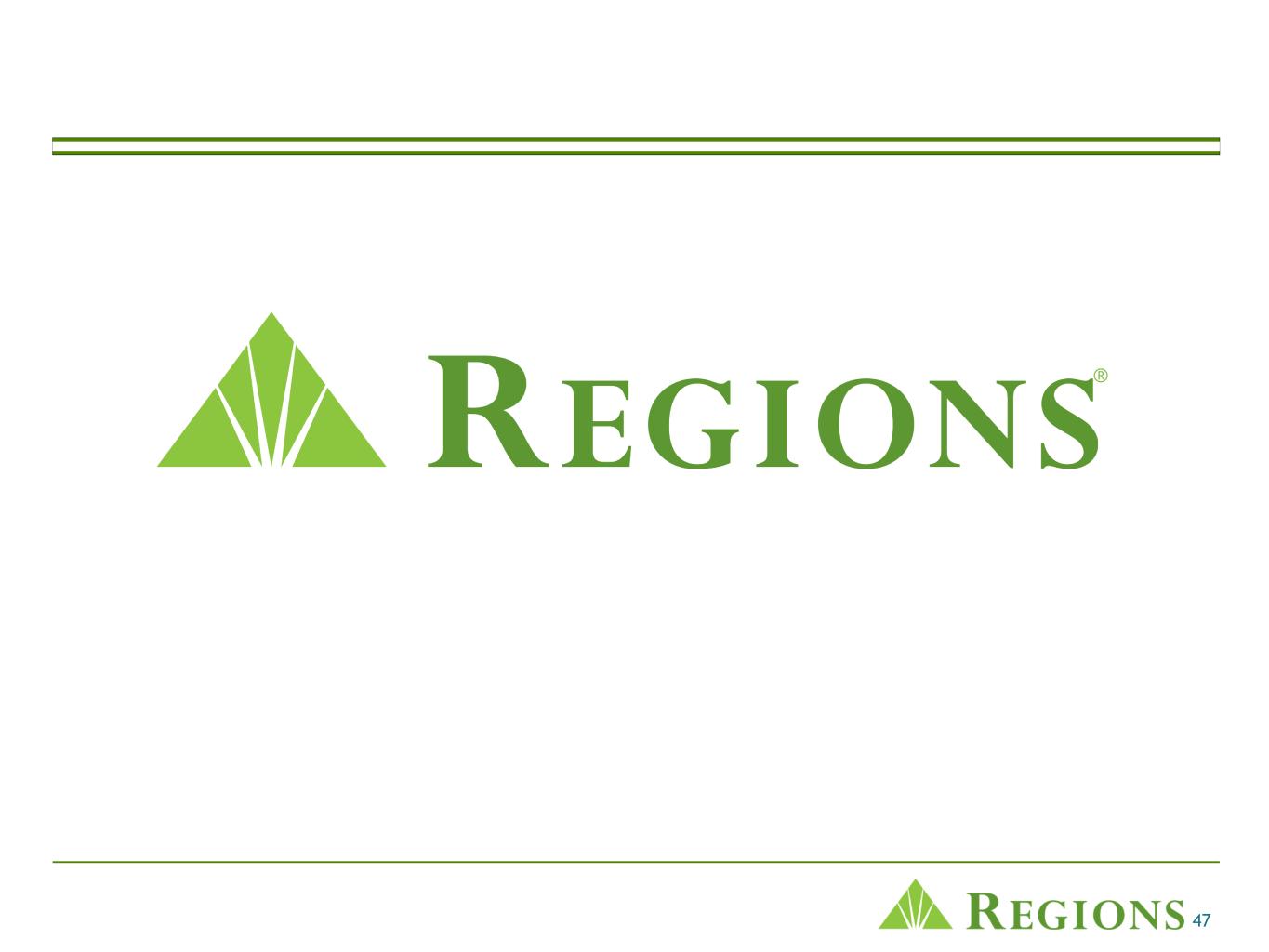
47 ®
��














































